- Invoice Generator
- Quotation Generator
- K53 Learners Material
- Community contributions
- My Questions
- My Comments
- Business Management
- Catalogue Catagories
- Business Settings
- Account Settings
- Invoice Settings
- Terms and Conditions
- Privacy Policy
- About / Get in touch
- Community Questions
K53 pre-trip inspection
K53 driver training learners pre trip inspection drivers license test 40
Who are you inviting:
- Exterior inspection
- Instrument inspection
- Interior inspection

Exterior Inspection
- Start at the drivers door, point to the under carriage of the vehicle and verbalize "There are no leaks and there are no obstructions under the vehicle"
- Wipers are not perished or broken
- Windscreen is not damaged
- Tyre is secure and inflated, the pressure and thread has been checked
- Headlights and indicators have been checked and are in working
- Bonnet is secure
- Engine Oil, Water, Fan Belt and Brake fluid has been checked
- The license disk is valid
- Passenger front wheel has been checked as before
- Fuel cap is closed and secure
- Rear Left wheel has been checked as before
- Boot lid is closed and secure
- Rear Lights and indicators have been checked and secure
- Rear right wheel has been checked as before
Instrument Inspection:
- Indicate right
- Indicate left
- Headlights on
- Bright light on
- Bright lights off
- Headlights off
- Put on your wipers
- Tap the hooter
- Put on the hazards
- Gear in reverse, to check the reverse light
- Put on your lights
- Apply brakes
Interior Inspection
- Your door is securely closed
- Your seat has been adjusted
- Your seat belt is fastened
- Your hand brake is engaged
- Gear in neutral
- All three mirrors are adjusted
- There are no loose items or obstructions on the dashboard
- There are no loose items or obstructions near the pedals
Your Answer:
- Only reply if you are confident in your answer.
- Check for spelling and grammar.
- Avoid in-appropriate remarks.
- If you need more information or clarity, post a comment first .
Use these fields to recommend a company or organisation, to quote a source or to reference your response.
By saving this content you are agreeing to our terms and conditions and privacy policy
- Avoid in-appropriate remarks and comments.
- If you'd like to thank the poster, you should cast a vote.
CDL Pre-Trip Inspection Checklist
Studying this Class-A CDL pre-trip inspection checklist is an important part of truck driver training. Before getting your Class-A CDL and finding an entry level truck driving job , most states will require students to pass a DOT (department of transportation) pre-trip inspection test and a general knowledge test .
Each company’s pre-trip inspection varies slightly. Most likely you will have to do the coupling system, light check and in-cab inspections plus one of the remaining three sections.
Pre Trip Inspection Checklist
Download free and print it! Printable Pre Trip Inspection Checklist (PDF)
There are many sections to learn but the test is not as difficult as it may seem. Studying our simplified Class-A pre-trip inspection checklist and taking classes at your local CDL training school will get you prepared.
Engine Compartment
Driver door fuel area, coupling area, light check, in-cab inspection and brake tests, belt driven alternator, belt driven water pump, brake chamber, brake lining, caste nuts and cotter pins, coolant reservoir, gear box and hoses, gear driven air compressor, gear driven power steering pump.
- General Hoses
Leaf Springs
Power steering fluid reservoir, shock absorber, slack adjuster and push rod, spring hanger, steering column, what to check for:.
When checking the engine compartment, you will always want to make sure the following components are properly mounted and secured. You should also make sure they are not cracked, bent or broken. The items you will need to check for include:
- Make sure all of the wires are connected. The belt should not be cracked or frayed and the free play on the belt should be between ½ to ¾ of an inch.
- The free play on the belt should be between ½ to ¾ of an inch. Also check all the hoses running to and from the water pump to make sure nothing is leaking.
- The brake chamber should not be leaking air.
- The brake drum should be properly mounted and secure.
- The brake hose is rubber, so it is important to make sure it is not leaking air.
- Check for oil or debris on the lining. There should be at least ¼ of an inch of friction material.
- Make sure all three caste nuts and cotter pins are present.
- The reservoir should not leaking and must be filled to the manufacturer’s specifications.
- Make sure the drag link is properly mounted and secure, and not cracked, bent or broken.
- The gear box and hoses should have no abrasions, bulges or cuts, and should not be leaking.
- Although the air compressor is hard to see, you must make sure it is properly mounted and does not leak.
- The steering pump is located in the same place as the air compressor and is also gear driven. Ensure the steering pump is not leaking.
General Hoses (Passenger and Driver’s Side)
- The hoses should be secure at both ends. There should be no abrasions, bulges or cuts. Fluids run through these hoses, so it is important to make sure they are not leaking.
- The hub seal (or axle seal) should not be leaking and should be filled to the manufacturer’s specifications.
- Make sure none of the leaf springs have shifted.
- Check for leaks under the truck.
- There should be no lug nuts missing. Look for rust trails, powder residue and cracks around the bolt holes.
- The oil level should be filled to the manufacturer’s specifications.
- Make sure the pitman arm is properly mounted and secure. It should be not cracked, bent or broken.
- Make sure this reservoir is not leaking and filled to the manufacturer’s specifications.
- The rim cannot have any unauthorized welds.
- Make sure the shock absorber is not leaking. If it is leaking, the leak will be at the point where the top and bottom portion of the shock meet.
- With the brakes released and pulled by hand, the push rod should never move more than one inch.
- The spring hanger should be properly mounted and secure.
- Make sure the steering column is properly mounted and secure. It should not be cracked, bent or broken.
- Look for abrasions, bulges or cuts on the tread or sidewalls. Tread depth should have a depth no less than 4/32 of an inch. Tires must be properly filled to the manufacturer’s specifications. This can be checked with an air gauge.
- Make sure the tie rod is properly mounted and secure, not cracked, bent or broken.
- Make sure all are accounted for.
Back to top of Engine Compartment
Catwalk and Steps
Door and hinges, drive shaft, exhaust system, frame and cross members, spring mount.
Again it is important to make sure these items are properly mounted and secure. Look for cracks, bends, and breaks.
- The actual airbag is rubber, so it is important to check for abrasions, bulges, cuts and leaks, in addition to any missing mounting bolts.
- The axle seal should not be leaking and should be filled to the manufacturer’s specifications.
- Make sure to mention the brake chamber is not leaking air.
- Make sure the brake drum is secured properly. Also look for cracks, bends and breaks.
- Check the brake hose at both ends to make sure it is not leaking air.
- There should be no oil or debris on the brake lining. There should be at least ¼ of an inch of friction material.
- The cat walk and steps should be clear of any loose objects.
- Physically demonstrate that the doors open, close and latch properly. Door seals should not be worn, torn or rotten.
- The drive shaft should not be twisted and the u-joints should be free of any debris.
- The tread and sidewalls should have no abrasions, bulges or cuts. The tread depth should be no less than 2/32 of an inch. Tires should be properly filled to the manufacturer’s specifications. This can be checked with an air gauge.
- The exhaust system should show no signs of leaks.
- There should be no unauthorized holes or welds. Bundle up the cross members to ensure none are missing.
- Fuel should not be leaking from the tank and the cap should always be on tight.
- Rust trails could indicate loose bolts, while powder residue and racks around the bolts could mean the bolts have been over-tightened.
- Mirrors should be clean for best visibility.
- Make sure the mud flap is secured properly. Also look for cracks, bends and breaks.
- Make sure to mention there should be never be any unauthorized welds.
- The shock absorber should be secure at both ends and not leaking. If it does leak, it will leak in the middle.
- With the brakes released and pulled by hand, the push rod should not move more than one inch.
- If you are equipped with duals, check to see there is proper spacing between the tires and there is nothing stuck.
- The spring arm should be secure at both ends.
- The spring mount should be secure at both ends.
- Make sure the torque arm is secured properly. Also look for cracks, bends and breaks.
- Make sure to check and mention that no U-bolts are missing.
Back to top of Driver Door Fuel Area
Electric Line
Locking jaws, mounting bolts, release arm, sliding fifth wheel locking pin.
- Air lines should be secure at both ends with no abrasions, bulges or cuts. They should not be leaking, dragging or tangled.
- Make sure the apron is properly mounted and secure. Look for cracks, bends and breaks.
- Make sure there is enough space between the tractor mudflap and the trailer landing gear so that they don’t hit each other when making a turn.
- The electric line should be secure at both ends. There should be no abrasions, bulges, cuts or exposed wires.
- The gap is not an actual item, however there should be no space between the apron and the skid plate.
- The seals should be in good condition with no cracks, signs of rotting, or leaking air.
- Make sure the king pin is properly mounted and secure. Look for cracks, bends and breaks.
- You must physically check that the locking jaws is fully locked around the king pin.
- No mounting bolts should be missing.
- Make sure the platform is properly mounted and secure. Look for cracks, bends and breaks.
- The release arm should be in the fully locked position.
- The skid plate needs to be properly lubed.
- The pin must be in the fully locked position.
Back to top of Coupling Area
Header Board
Landing gear, rear door and hinges.
- Shock Absorbers
Tandem Frame and Release
Trailer tire.
- Again make sure the airbag has no abrasions, bulges, cuts or leakings. The airbag should not be missing any mounting bolts.
- The brake chamber should be properly mounted so that is does not leak air.
- The brake hose should be secure at both ends with no abrasions, bulges, cuts or leaks.
- Check for oil or debris on the brake lining. There should be at least ¼ of an inch of friction material.
- There cannot be any missing cross members.
- The header board cannot have any holes or missing rivets.
- The landing gear must be fully raised and the cradle handle secure.
- Rust trails indicate loose bolts. Powder residue and cracks around the bolt holes could be an indication of over-tightened bolts.
- The rims cannot have any unauthorized welds.
- The rear door should open, close and latch properly. Door seals should not be worn, torn or dry rotten.
- The shock absorber should be checked at both ends for leaks.
- When the brakes are released and pulled by hand, the push rod should not move more than one inch.
- Release handle and locking pins should be in the fully locked position.
There should be no abrasions, bulges or cuts to the tread or sidewalls. Tread depth should be no less than 2/32 of an inch. The tire should be properly filled to manufacturer’s specifications and checked with an air gauge.
- Front of the truck
- Both sides of the truck
- Rear of the truck
- Both sides of the trailer
- Rear of the trailer
Back to top of Trailer
The five functions are:
- Left turn signal
- Right turn signal
- Four way flashers
- High/low beams
- Brake lights
Back to top of Light Check
- Airbrake Test
Air Pressure Gauges
Emergency equipment, heater and defroster, lighting indicators, oil pressure gauge, parking brake, service brake check, water temperature gauge, windshield and mirrors, windshield wipers and washers.
The last section is In-Cab Inspection and Brake Tests. For the In-Cab Inspection you will once again want to make sure all of the following components are properly mounted and secure. As well as the following:
Air Brake Test
There are three stages to an air brake test:
- Applied Pressure Test – When doing the Applied Pressure Test, you will want to build the air pressure to governor cut out. Put the truck in the lowest gear, turn the engine off and immediately turn it back on. Push in the tractor and trailer valves which will then release the parking brakes. Push and hold the brake pedal, allowing the gauges to stabilize. When the gauges have stabilized, announce the Primary and Secondary PSI. Listen for air leaks while doing this.
- Warning Light and Buzzer – Pump down on the brake pedal until the warning light and buzzer comes on. This is typically at or before 60 PSI.
- Tractor/Trailer Protection Valve Pop Out – Pump down on the brake pedal until the tractor and trailer protection valves pop out, this will be between 20 and 40 PSI.
- The air pressure gauges should build to governor cut out.
- Your truck should have a fire extinguisher, three red reflective triangles and spare electrical fuses.
- Demonstrate both the heater and defroster are working properly.
Horns (Air Horn and City Horn)
- Blow both horns to make sure they are working.
- Check the left turn, right turn, four way flashers and high beams; also point these out on the dashboard.
- Make sure transmission is in neutral and then fully depress the clutch. Turn the key on, check the ABS light, announce when it comes on and off, and start the engine.
- The seat belt should not be ripped or frayed and should adjust and latch properly.
- The engine oil pressure gauge should rise to normal operating range.
- Trailer Parking Brakes – Set the trailer brake, release the tractor brake, then tug lightly on the trailer.
- Tractor Parking Brakes – Set the tractor brake, release the trailer brake and tug lightly on the trailer.
- Release both the tractor and trailer brakes. Drive at idle speed. Apply the service brake to make sure you come to a complete stop and that it doesn’t pull to the left or right when applying the brakes.
- The voltmeter should be charging between 13 and 14 volts.
- The water temperature gauge should also rise to normal operating range.
- The windshield and mirrors must be clean, with no obstructions and in proper adjustment.
- Demonstrate the wipers and washers are working properly by spraying the windshield.
Back to top of In-Cab Inspection and Brake Tests
During a CDL pre-trip inspection, truckers inspect many aspects of their commercial vehicle, including the overall safety of the vehicle; major hoses, fluid levels, and vehicle belts; the clutch or gear shift; and emergency equipment. The driver demonstrates their knowledge by walking around the vehicle, checking various safety components and explaining why each part should be checked for safety.
Reference and practice tests:
- Printable Pre Trip Inspection Checklist (PDF)
- CDL General Knowledge Practice Test
- Pre Trip Inspection Practice Test
- CDL HAZMAT Endorsement Practice Test
Edited for 2024 on 12/5/23
- Free Practice Tests
Commercial Driving
- Introduction
Getting a CDL
- Fees and costs
CDL Types & Permits
Endorsements & Restrictions
CDL Exam Preparation
Written exams
Practical exams
- Skills test
- Pre-trip inspection
- TSA background check
- Retake policy
CDL Maintenance
ELDT Training & Certification
CDL how-to guides

Important Notice – Covid 19
- All staff had training on Covid-19.
- All vehicles are equipped with vehicle sanitiser for after each lesson as well as sanitiser for client and Instructor.
- Clients will be screened before each lesson with a questionnaire.
- Face masks are mandatory when doing training.
Code C1 (10) K53 Driving Lessons
With 50 years of experience in K53 driver training, He and She instructors will assist you to obtain your code C1 (C1) driver license. We supply training in all areas in the Cape Town and surrounding areas (Western Cape Peninsula).
Why use He and She
- All driving lessons are based on the K53 curriculum
- All lessons are 1 hour long (excluding travelling time)
- All vehicles are comprehensively insured
- All vehicles are fitted with dual controls
- All our instructors are in possession of instructor certificates
- Our vehicles are new and 100% roadworthy and well maintained
- We constantly strive to improve our training methods
- We have our own practise yard in the Western Cape which is marked according to K53 requirements
*Please note that addition park yard fees might be applicable to clients further than 15km of our head office.
Requirements
You need to be over the age of 18 years, with a valid learners licence, in order to drive on a public road with an instructor or person with a valid drivers licence present in the vehicle at all times.
To book a K53 driver test you will need:
Learner license ID book or ID card Proof of address
Also have your eyes tested before making a test appointment at the traffic department and should you wear spectacles, be sure to bring them along.
Course Content
Pre-trip inspection Manoeuvres in the yard Driving on the road Practical in-truck training (1 client: 1 instructor) Patient instructors All vehicles are comprehensively insured All vehicles are fitted with dual controls Highly trained instructors with instructor’s certificates Our administration division handles all the instructors booking and payments so there will be no interruptions during your lesson Remember to always have your learners licence when attending a lesson.
How to Book
Book Online with a Credit Card or EFT We have listed our driving lessons packages below. Please click on the ‘Purchase X Hours’ to make an online booking and pay either by EFT or with a Credit Card. Once your payment reflects in our bank account, one of our office staff will contact you to book your first lesson.
Book Via Email Should you wish to make a booking via our online registration form: Click Here
Or alternatively send an email to this address: [email protected]
Book Via Telephone Should you wish to book by telephone please either click the number or call us at: 021 931 8214
CODE C1 (10)
Goal: To prepare the learner driver to pass the K53 driver license test at the traffic department.
Module 1: Pre-trip inspection Module 2: Drive the vehicle in traffic and on freeways Module 3: Manoeuvring the vehicle (Alley docking, Incline start, straight reverse)
When: Any Monday to Friday (07h00 – 17h00) OR Saturdays: (07h00 – 15h00)
Recommended amount of lessons:
As driving is an acquired skill, the amount of lessons needed would depend on previous knowledge and personal progress. A novice driver would need about 20 – 30 hours.
Training starts at our offices, 1 Duncan Street, Parow Valley
Code C1(10) Driving Lesson Packages
**PLEASE NOTE: ALL PACKAGES LISTED BELOW ARE FOR ONLINE BOOKINGS FOR THE CAPE TOWN BRANCH ONLY.
- Professional driving lessons
- Based on K53
- Patient instructor
- Driving lessons start from He and She
- Traffic fees excluded
Code 10 Pre-Trip Inspection
- There are no leaks or obstructions under or around the vehicle.
- The Vehicle’s seat belt & the door is working as intended.
- The vehicle’s mirror & windshield is fixed and secure.
- The vehicle’s wiper-blade un-perished.
- The Vehicle’s tyre tread is within spec and the tyre pressure has been checked.
- The wheel nuts are tight and the wheel is secured to the vehicle.
- The headlights are secured to the vehicle and the bonnet is closed and secure.
- I have checked the vehicle’s water level, oil level, brake fluid & fan belt.
- The left side of the vehicle is the same as previous side.
- Licence disc is up to date and secured to the left-hand side of the windshield.
- The vehicle’s petrol cap is closed and secure.
- Back vehicle’s window and tail lights are secure (not cracked) and the boot is closed securely.
- The vehicle’s back door & tyre is the same as previous.
Code 10 Ally Docking
Alley docking is a reverse manoeuvre which is done in the yard test and forms part of the K53 driving license test.
- SETTING YOUR VEHICLE UP FOR THE ALLEY DOCKING PROCEDURE. The traffic official will direct you to a marked square from where you will start the alley docking procedure. You need to obey all the rules of the road as you approach the starting point. Stop your vehicle within the marked square with your handbrake up and make sure the vehicle is in neutral.
- STARTING THE MANOEUVRE Check your rear view mirror and blind spot before indicating towards the appropriate side. Select the reverse gear and balance the clutch. Perform a 360-degree observation (blind spot, rear-view mirror, opposite blind spot) starting from the opposite side of the turning direction. Release the handbrake before moving off slowly.
- REVERSING THE VEHICLE Remember the slower you move the vehicle the more time you have to think and react. Check the blind spot on the opposite side of your turning direction once more before turning your steering wheel to start moving into the alley. Guide rear end of the car initially by looking over your shoulder. Check the vehicle’s side mirrors as you approach the alley to align the car between the parking poles.
- STOPPING INSIDE THE ALLEY Look over your shoulder and stop the vehicle inside the marked square. Be careful not to know over the pole behind you. Pull up the vehicle’s handbrake and put the vehicle in neutral.
View All Courses
Username or email *
Password *
Remember me Login
Lost your password?
Create an account?

- Subscription Plan
- Newsletters
The Ultimate Guide to Mastering Trucking Pre Trip Inspections

Trucking pre trip inspections are an essential part of a truck driver’s routine. Before hitting the road, truck drivers must conduct a thorough inspection of their vehicles to ensure they are in proper working order. This includes checking various components such as tires, brakes, lights, and fluid levels. The purpose of these inspections is to identify any potential issues that could compromise safety or lead to breakdowns on the road.
Importance of Pre Trip Inspections for Truck Drivers
Ensuring safety on the road is the primary reason why pre trip inspections are crucial for truck drivers. By thoroughly inspecting their vehicles before each trip, drivers can identify any potential safety hazards and address them promptly. This not only protects the driver but also other road users who may be affected by a malfunctioning truck.
Compliance with federal regulations is another significant reason why pre trip inspections are important for truck drivers. The Federal Motor Carrier Safety Regulations (FMCSRs) require truck drivers to conduct pre trip inspections and keep records of these inspections. Failure to comply with these regulations can result in penalties and fines, which can have serious consequences for both the driver and the trucking company.
Preventing breakdowns and delays is yet another reason why pre trip inspections are vital for truck drivers. By identifying any potential issues before hitting the road, drivers can address them proactively, reducing the risk of breakdowns and subsequent delays in delivery. This not only helps maintain a good reputation for the driver and the company but also ensures that cargo arrives on time.
Protecting cargo and equipment is also a critical aspect of pre trip inspections. By thoroughly inspecting their vehicles, drivers can identify any issues that could potentially damage or compromise the cargo they are transporting. This includes checking for secure load restraints, ensuring proper temperature control for perishable goods, and verifying that all equipment necessary for safe transportation is in good working order.
Do not allow a company to tell you the following: oh you can fix it later, or you can fix it after you make delivery.
A lot of trucking company’s will ask there employee drivers to do such.

doing your daily inspection may save your life or others
Understanding the Federal Motor Carrier Safety Regulations (FMCSRs)
The Federal Motor Carrier Safety Regulations (FMCSRs) are a set of rules and regulations established by the Federal Motor Carrier Safety Administration (FMCSA) to ensure the safe operation of commercial motor vehicles. These regulations cover various aspects of trucking, including pre trip inspections.
The FMCSRs require truck drivers to conduct pre trip inspections before each trip and document the results of these inspections. The inspections must be thorough and cover specific components of the vehicle, such as brakes, tires, lights, steering, and suspension. Drivers must also ensure that all required safety equipment, such as fire extinguishers and reflective triangles, are present and in good working order.
Non-compliance with the FMCSRs can result in penalties and fines. The severity of these penalties depends on the nature of the violation and can range from monetary fines to suspension of driving privileges. It is essential for truck drivers to familiarize themselves with the FMCSRs and ensure they are in compliance to avoid these penalties.
A comprehensive pre trip inspection checklist is a valuable tool for truck drivers to ensure they cover all necessary components during their inspections. While specific checklists may vary depending on the company or individual preferences, there are some key components that should be included in any pre trip inspection checklist.
Firstly, drivers should inspect the tires thoroughly. This includes checking for proper inflation, tread depth, and any signs of damage or wear. Properly inflated and well-maintained tires are crucial for safe and efficient operation on the road.
Secondly, brakes should be carefully inspected. This includes checking brake pads, drums or rotors, brake lines, and ensuring proper brake fluid levels. Faulty brakes can lead to accidents or breakdowns, so it is essential to identify any issues before hitting the road.
Lights and signals are another critical component of a pre trip inspection. Drivers should check all exterior lights, including headlights, taillights, brake lights, and turn signals, to ensure they are functioning correctly. This is crucial for visibility and signaling intentions to other road users.
Other components that should be included in a comprehensive pre trip inspection checklist are steering and suspension systems, fluid levels (such as oil, coolant, and windshield washer fluid), mirrors and windshield wipers, and safety equipment such as fire extinguishers and reflective triangles.
Common Pre Trip Inspection Failures and How to Avoid Them
Despite the importance of pre trip inspections, there are common failures that truck drivers may encounter. By being aware of these failures and taking proactive measures to prevent them, drivers can ensure the safety and efficiency of their journeys.
One common failure is neglecting to check tire pressure and tread depth. Improperly inflated tires can lead to increased fuel consumption, reduced traction, and increased risk of blowouts. Drivers should regularly check tire pressure and ensure it is within the recommended range. Additionally, monitoring tread depth is crucial to maintain proper traction on the road.
Another common failure is overlooking brake issues. Faulty brakes can lead to accidents or breakdowns, posing a significant risk to the driver and other road users. Regularly inspecting brake pads, drums or rotors, and brake lines can help identify any issues before they become more severe.
Failure to inspect lights and signals is another common issue. Properly functioning lights are crucial for visibility and signaling intentions to other road users. Drivers should regularly check all exterior lights, including headlights, taillights, brake lights, and turn signals, to ensure they are working correctly.
To avoid these common failures, drivers should follow a comprehensive pre trip inspection checklist, allocate sufficient time for inspections, be meticulous in their approach, and address any identified issues promptly.
Even though An inspection may have been performed, failure can occur at any moment because of mechanical failure, part age or failure.
So after each inspection snap a couple of pictures of the vehicle left side, right side, front, and back. This way if something does fail beyond and outside your control, you have a picture with a time stamp on it. By doing this you may save yourself from a potential lawsuit or getting canned.
Just like humans we all have our failures and so do parts on trucks
Travel Safe Truckersword.com

CB Lingo 101: How to Speak Like a Pro on the Road, warnings ahead
Fuel up with flavor: what are your favorite places to eat.

Leave a reply Cancel reply
You must be logged in to post a comment.
Trending posts

Honoring Our Heroes: Why American Veterans Deserve Our Respect
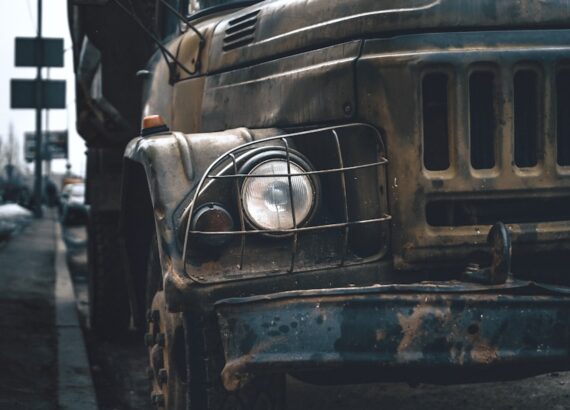
The High Cost of Tiredness: Exploring the Consequences of Fatigue in Trucking
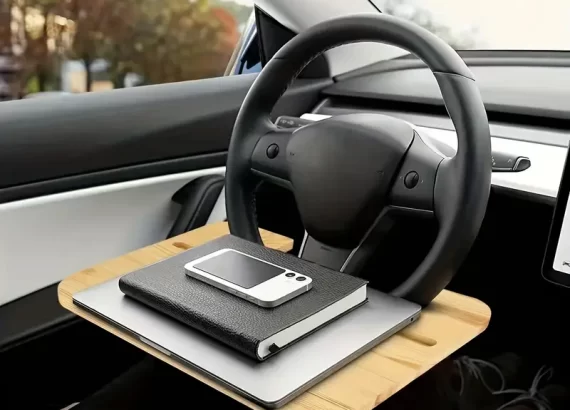
Is Your Truck Company Compliant
Recent posts.


- All Companies
- Driver Training
- All Freight Types
- Lease/Purchase
- Message Board
- Truck Driver Salary
- How to Become A Truck Driver
- Will I Be Successful?
- Truck Driving Schools
- CDL Practice Tests
- Get Your CDL
- Get Your First Truck Driving Job
- Your First 100,000 Miles
- Advanced Tips
- Sign Up Here
Select Location x
Please tell us your location.
Location not set
The Complete Pre-Trip Inspection Checklist
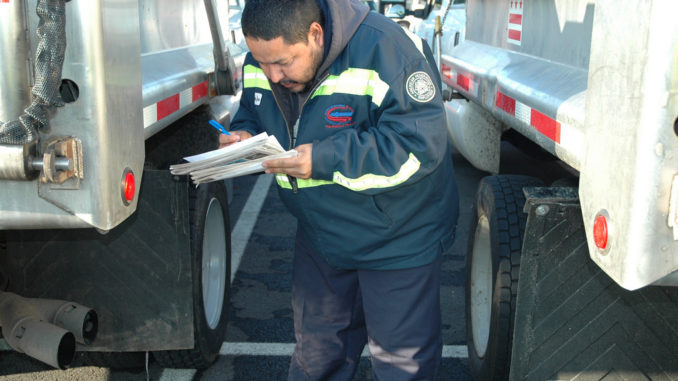
Due to heavy memorization, the pre-trip inspection is one of the hardest aspects of the CDL test. Also called the “Vehicle Inspection Test,” the pre-trip is one of the tests that trucking students fail the most.
With this pre-trip inspection checklist, we tell you everything you need to know and what you need to check for.
Engine Compartment – What to Check For:
When checking the engine compartment, you always want to make sure the following components are properly mounted and secured. You should also make sure they are not cracked, bent, or broken. The items you need to check for include:
Belt-Driven Alternator
All of the wires are connected. The belt is not cracked or frayed, and the free play on the belt is between ½ to ¾ of an inch.
Belt-Driven Water Pump
The free play on the belt is between ½ to ¾ of an inch, and all the hoses running to and from the water pump are tightly clamped. Ensure nothing is leaking.
Brake Chamber
The brake chamber is not leaking air.
The brake drum is properly mounted and secure.
The brake hose is rubber; it is not cracked and is not leaking air.
Brake Lining
Check for oil or debris on the lining. There should be at least ¼ of an inch of friction material.
Caste Nuts and Cotter Pins
All three caste nuts and cotter pins are present.
Coolant Reservoir
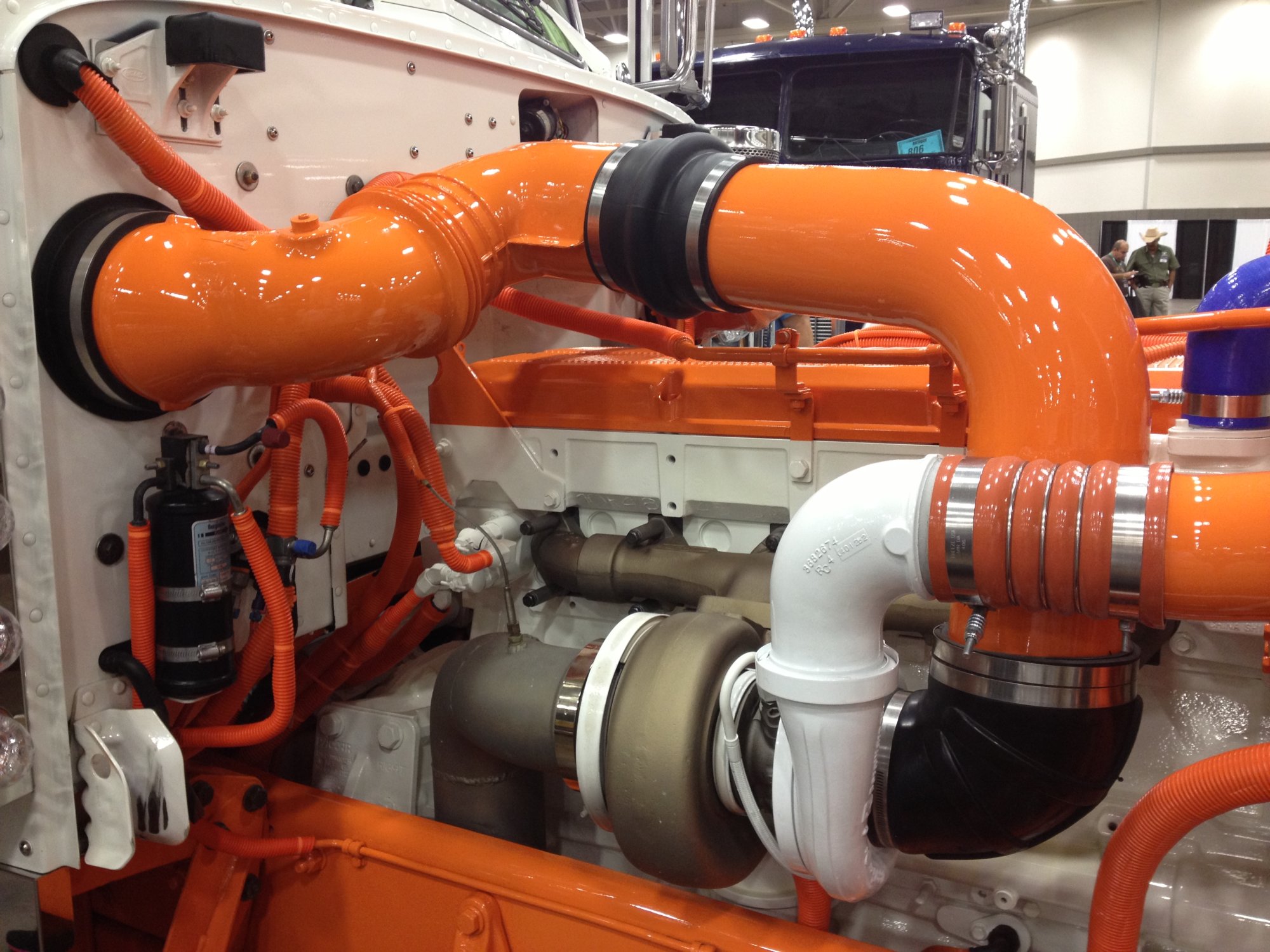
The reservoir is not leaking and is filled to the manufacturer’s specifications.
The drag link is properly mounted and secure, and not cracked, bent or broken.
Gear Box and Hoses
The gear box and hoses have no abrasions, bulges or cuts, and are not leaking.
Gear-Driven Air Compressor
The air compressor is properly mounted and does not leak.
Gear-Driven Power Steering Pump
The steering pump is properly mounted and not leaking.
General Hoses (Passenger and Driver’s Side)
The hoses are secure at both ends and are not leaking. There are no abrasions, bulges, or cuts.
The hub seal (or axle seal) is leaking and is filled to the manufacturer’s specifications.
Leaf Springs
None of the leaf springs have shifted or are bent or broken.
There are no signs of leaks under the truck.
There are no lug nuts missing. There are no rust trails, powder residue, or cracks around the bolt holes.
The oil level is filled to the manufacturer’s specifications.
The pitman arm is properly mounted and secure. It is not cracked, bent, or broken.
Power Steering Fluid Reservoir
The power steering reservoir is not leaking and is filled to the manufacturer’s specifications.
The rim does not have any unauthorized welds.
Shock Absorber
The shock absorber is not leaking. If it is leaking, the leak will be at the point where the top and bottom portion of the shock meet.
Slack Adjuster and Push Rod
With the brakes released and pulled by hand, the push rod does not move more than one inch.
Spring Hanger
The spring hanger is properly mounted and secure.
Steering Column
The steering column is properly mounted and secure. It is not cracked, bent, or broken.
There are no abrasions, bulges, or cuts on the tread or sidewalls. Tread depth should have a depth no less than 4/32 of an inch. Tires are properly filled to the manufacturer’s specifications. This can be checked with an air gauge.
The tie rod is properly mounted and secure, not cracked, bent, or broken.
Make sure all are accounted for.
Driver Door Fuel Area-What to Check For:
Remember – during the pre-trip inspection, you want to make sure these items are properly mounted and secure. Look for cracks, bends, and breaks.
The actual airbag has no abrasions, bulges, cuts, or leaks. The airbag is not missing mounting bolts.
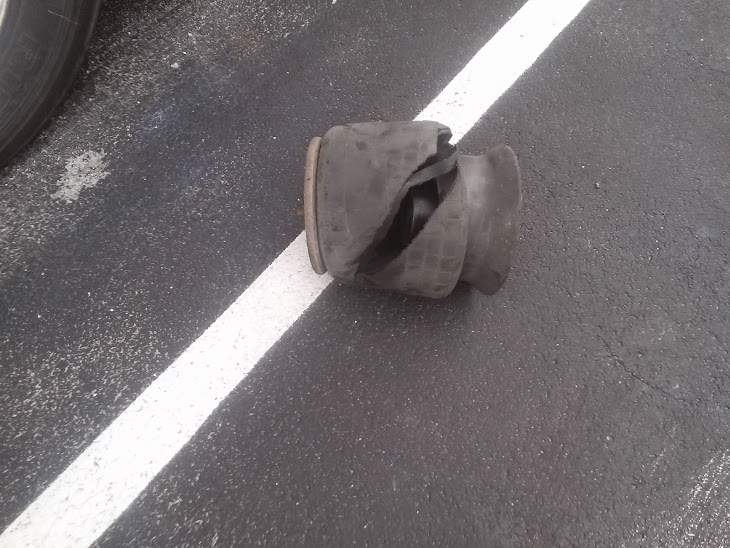
The axle seal is not leaking and is filled to the manufacturer’s specifications.
The brake drum is secured properly and has no cracks, bends or breaks.
Check the brake hose at both ends to make sure it is not leaking air.
There is no oil or debris on the brake lining. There is at least ¼ of an inch of friction material.
Catwalk and Steps
The cat walk and steps are clear of any loose objects.
Door and Hinges
The doors open, close, and latch properly. Door seals should not be worn, torn, or rotten.
Drive Shaft
The drive shaft is not twisted, and the u-joints are free of any debris.
The tread and sidewalls have no abrasions, bulges, or cuts. The tread depth is no less than 2/32 of an inch. Tires are properly filled to the manufacturer’s specifications. This can be checked with an air gauge.
Exhaust System
The exhaust system shows no signs of leaks.
Frame and Cross Members
There are no unauthorized holes or welds. Bundle up the cross members to ensure none are missing.
Fuel is not leaking from the tank, and the cap is on tight.
There are no rust trails, loose bolts, powder residue, or cracks around the bolts.
Mirrors are clean, with no cracks or chips.
The mud flap is secured properly, with no cracks, bends and breaks.
There are no unauthorized welds.
The shock absorber is secure at both ends and not leaking. If it does leak, it is preferable to leak in the middle.
There is proper spacing between the tires and there is nothing stuck.
The spring arm is secure at both ends.
Spring Mount
The spring mount is secure at both ends.
The torque arm is secured properly, with no cracks, bends or breaks.
No u-bolts are missing.
Coupling Area-What to Check For:
Air lines should be secure at both ends with no abrasions, bulges, or cuts. They should not be leaking, dragging, or tangled.
Make sure the apron is properly mounted and secure. Look for cracks, bends, and breaks.
Make sure there is enough space between the tractor mud flap and the trailer landing gear, so that they don’t hit each other when making a turn.
Electric Line
The electric lines are secure at both ends. There are no abrasions, bulges, cuts, or exposed wires.
There is no space between the apron and the skid plate.
The seals are in good condition with no cracks, signs of rotting, or leaking air.
The king pin is properly mounted and secure, without cracks, bends and breaks.
Locking Jaws
Physically check that the locking jaws are fully locked around the king pin.
Mounting Bolts
No mounting bolts are missing.
The platform is properly mounted and secure, without cracks, bends and breaks.
Release Arm
The release arm is in the fully locked position.
The skid plate is properly lubed.
Sliding Fifth Wheel Locking Pin
The pin is in the fully locked position.
Trailer- What to Check For :
The airbag has no abrasions, bulges, cuts or leaks, not missing any mounting bolts.
The brake chamber is properly mounted and does not leak air.
The brake hose is secure at both ends with no abrasions, bulges, cuts, or leaks.
No oil or debris on the brake lining and at least ¼ of an inch of friction material.
No missing cross members.
Header Board
The header board does not have any holes or missing rivets.
Landing Gear
The landing gear is fully raised and the cradle handle secure.
No rust trails, powder residue, or cracks around the bolt holes.
The rims do not have any unauthorized welds.
Rear Door and Hinges
The rear door opens, closes, and latches properly. Door seals are not worn, torn, or dry rotten.
The shock absorber is secure at both ends with no leaks.
When the brakes are released and pulled by hand, the push rod does not move more than one inch.
Tandem Frame and Release
Release handle and locking pins are in the fully locked position.
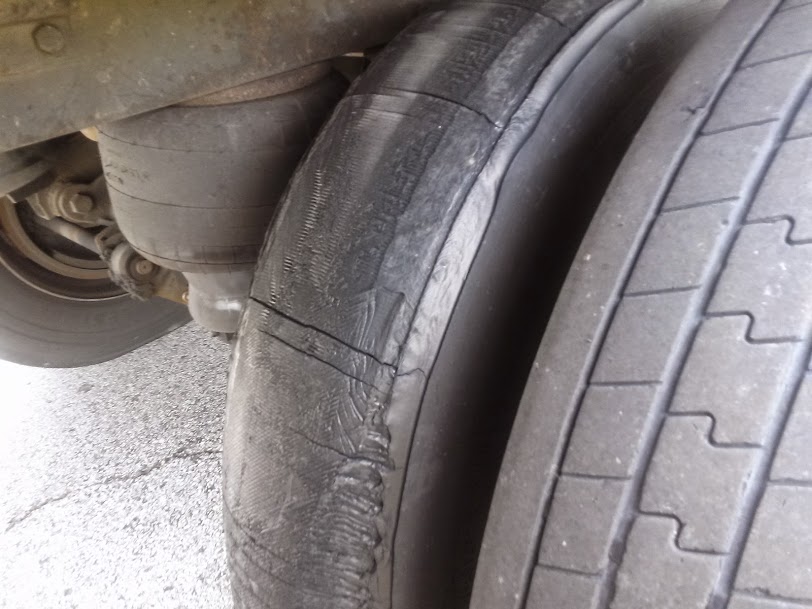
Trailer Tire
There are no abrasions, bulges, or cuts to the tread or sidewalls. Tread depth is no less than 2/32 of an inch. The tire is properly filled to manufacturer’s specifications and checked with an air gauge.
Light Check
There are five locations where you must check your lights. These include:
- Front of the truck
- Both sides of the truck
- Rear of the truck
- Both sides of the trailer
- Rear of the trailer
The five functions are:
- Left turn signal
- Right turn signal
- Four way flashers
- High/low beams
- Brake lights
Inspection and Brake Tests-What to Check For: In-Cab
The last section is In-Cab Inspection and Brake Tests. For the In-Cab Inspection you once again want to make sure all of the following components are properly mounted and secure. As well as the following:
Air Brake Test
There are three stages to an air brake test:
- Applied Pressure Test – When doing the Applied Pressure Test, you want to build the air pressure to governor cut out. Put the truck in the lowest gear, turn the engine off and immediately turn it back on. Push in the tractor and trailer valves which then release the parking brakes. Push and hold the brake pedal, allowing the gauges to stabilize. When the gauges have stabilized, announce the Primary and Secondary PSI. Listen for air leaks while doing this.
- Warning Light and Buzzer – Pump down on the brake pedal until the warning light and buzzer comes on. This is typically at or before 60 PSI.
- Tractor/Trailer Protection Valve Pop Out – Pump down on the brake pedal until the tractor and trailer protection valves pop out, this will be between 20 and 40 PSI.
Air Pressure Gauges
The air pressure gauges build to governor cut out.
Emergency Equipment
Truck has a fire extinguisher, three red reflective triangles, and spare electrical fuses.
Heater and Defroster
Demonstrate both the heater and defroster are working properly.
Horns (Air Horn and City Horn)
Blow both horns to make sure they are working.
Lighting Indicators
Check the left turn, right turn, four way flashers and high beams; also point these out on the dashboard.
With the transmission in neutral, fully depress the clutch. Turn the key on, check the ABS light, announce when it comes on and off, and start the engine.
The seat belt is not ripped or frayed and adjusts and latches properly.
Oil Pressure Gauge
The engine oil pressure gauge should rise to normal operating range.
Parking Brake
- Trailer Parking Brakes – Set the trailer brake, release the tractor brake, and tug lightly on the trailer.
- Tractor Parking Brakes – Set the tractor brake, release the trailer brake, and tug lightly on the trailer.
Service Brake Check
Release both the tractor and trailer brakes. Drive at idle speed. Apply the service brake to make sure you come to a complete stop and that it doesn’t pull to the left or right when applying the brakes.
The voltmeter is charging between 13 and 14 volts.
Water Temperature Gauge
The water temperature gauge rises to normal operating range.
Windshield and Mirrors
The windshield and mirrors are clean, with no obstructions and in proper adjustment.
Windshield Wipers and Washers
Demonstrate the wipers and washers are working properly by spraying the windshield.
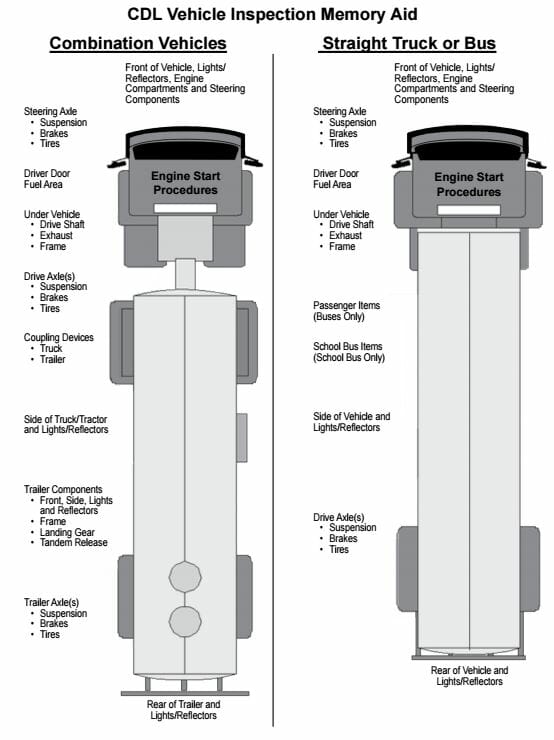
This is a really nice complete list, very useful.
Comments are closed.
Contact ClassADrivers.com
Please use the form below to contact our customer service or sales team.
You can also reach us at (888) 830-2326. Our normal business hours are Monday-Friday 8 a.m. to 5 p.m. (Pacific Time).
Our business address is: Attn: Class A Drivers MH Sub I, LLC dba Internet Brands 909 N Pacific Coast Highway, 11th Floor El Segundo, CA 90245
By clicking the ["Send"] button, you agree to our Terms of Use and Privacy Policy , and to the use of cookies described therein, and you also consent to the collection, storage, and processing of your data in the United States where the level of data protection may be different from that in your country.
Complete pre-trip inspection checklist for truck drivers
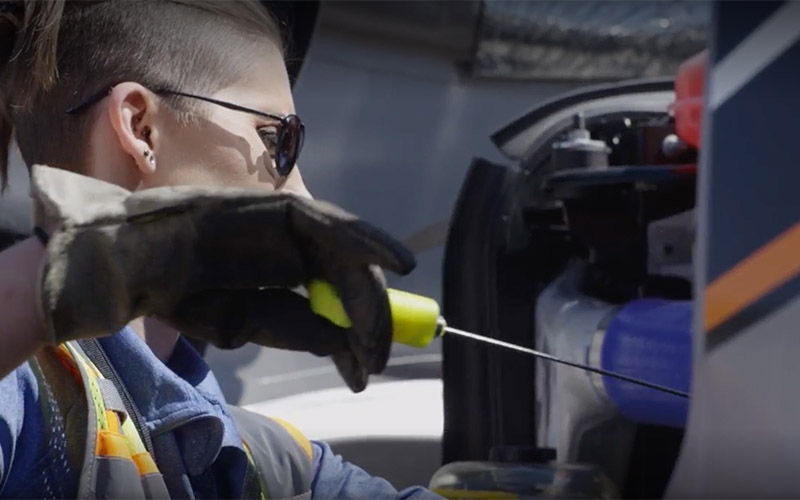
By The Schneider Guy
Estimated reading time: 4 minutes
As a truck driver, performing a CDL pre-trip inspection is one of the most common and repeated tasks you will complete. Pre-trip inspections help truck drivers ensure their tractor and trailer are safe to operat e before hitting the road.
Keep reading to learn what a p re -trip inspection is and what should be on a p re -trip inspection checklist .
What is a pre-trip inspection?
A pre-trip inspection includes checking over the tractor and trailer a truck driver will be operating . A pre-trip should be completed before the operation of a vehicle :
- At the beginning of a driver’s shift.
- Any time a new trailer is picked up.
- After a 10-hour break.
A thorough inspection usually takes anywhere from 30 minutes to one hour and should be logged as on-duty, not driving (line 4) .
How to complete a CDL pre-trip inspection
CDL pre-trip inspection checklist
1. passenger-side engine: .
- Air filter housing: Secure mounting, cover in place.
- Windshield washer fluid reservoir: No leaks, proper fluid level.
- Turbocharger: No oil or exhaust leaks.
- Engine air ductwork: No cuts, clamps secured.
- Alternator: Mounting secured, no broken or loose wire.
- Accessory drive belt: Not cracked or frayed.
- Air conditioner compressor: Secure m ounting .
2. Front brakes (covers all five brake components):
- Brake drum: No cracks.
- Brake lining: No cracks or damage.
- Slack adjuster: Proper angle to the brake chamber, clevis and cotter pin intact.
- Brake air line: No bulges or cuts, fitting tight .
- Brake chamber: Mounting bolts secured, band clamp secured.
3. Front wheel:
- Tire: ABCs (abrasions, bulges, cuts), pressure = 120 PSI, tread depth = 4/32 min ( DOT ) .
- Wheel: Not cracked or bent.
- Hub oil: Not leaking, at proper level – if it’s a sealed unit, can’t check level.
- Oil seal (outer): Not leaking.
- Valve cap: Not missing.
- Lug nuts: None missing, no streaks or shiny areas, none loose.
4. Driver side of engine:
- Radiator brace: No cracks or missing bolts.
- Radiator: Not leaking, secure mounting.
- Water pump: No cracks, not loose or leaking.
- Fuel water separator/filter: Not leaking, secure mounting.
- Pitman arm/drag link: Not cracked, castle nut secured with cotter pin.
- Steering gear box: Secure to frame, not leaking.
- Power steering reservoir: Secure mounting , no leaks, proper level.
- Dipstick: Right level, secured after check.
- Steering shaft: Secure, not loose or damaged.
- Fuel pump: No cracks, not loose or damaged.
- Oil filler cap: Secure, no cracks.
- Engine coolant reservoir: No leaks, proper fluid level.
5. Steer axle suspension:
- U-bolts: No cracks, no loose or missing nuts.
- Leak spring: No cracks, not loose or shifting.
- Tie rod: Secured with castle nuts and cotter pins.
- Shock absorber: Secure mounting, not leaking oil.
- Axle: Not cracked.
6. Rear suspension:
- Spring mount: No cracks, secure mounting.
- Tire: ABCs (abrasions, bulges, cuts), pressure = 110 PSI, tread depth = 2/32 min ( DOT ) .
- Airbag (bellows): Fully inflated, secure mounting, not ruptured.
7. Side of cab:
- Mirrors: Secure m ounting , no broken glass.
- Doors: No damage, glass not broken, hinges secured, opens and closes well.
- Lights and turn signals: Working, not cracked.
- Steps: Mounted, secured to skirting.
- Battery box: Secure m ounting , cover latched.
- DEF cap: Cap secured.
- Fuel cap/tank: Gasket in place, vent in place, chain secures the cap to the tank.
- Side skirting: No damage, panels secure.
- Side box: Secured, safety triangles present.
- Side of sleeper berth: No body damage.
- Sleeper berth window: No cracks.
8. Rear of cab:
- Electrical cord: No bare wire, no corrosion, check the plug at the end of the cord.
- Air line: Not tangled or worn, rubber grommets not worn, fittings tight.
- Cab shock absorber: Secure mounting, not leaking oil.
- Cab airbag (bellows): Not ruptured, securely mounted.
9. Driveshaft/rear frame:
- Driveshaft: Not cracked.
- Universal joint: Not cracked, not missing bolts, no shiny areas.
- Differential: Not leaking oil.
- Frame: Straight, no non-factory welds.
10. Fifth wheel area:
- Pivot pin: Keeper pin and cotter key intact.
- Slider lock pins: Fully engaged.
- Release arm: Not bent.
- Slider rail: No broken welds or missing bolts.
- Slider stop blocks: Welds not broken, not missing bolts.
- 5th wheel platform: Well-greased, tilted down.
11. Front of trailer:
- Top rail: No cracks or collision damage.
- Clearance lights: Not broken, working properly.
- Registration: Not missing, readable.
- Document box: Not missing or loose.
- Air line /glad hands: No bulges or cuts in air lines, rubber grommets not damaged on glad hands.
- Electric hook up: No broken pins, cover intact.
- PM sticker: Current, legible.
- Height sticker: Legible, legal for route.
- Placard holder: Not broken or missing rivets.
- Tracking device: No cracks or collision damage.
12. Side of trailer:
- Top rail: Not cracked, no collision damage.
- Clearance light: Not broken, operational.
- Bottom light: Not cracked, no collision damage, no missing bolts.
- Landing gear: Legs straight, no broken welds in bracing, sand pads secured and clean handle in cradle.
- Reflector tape: Clean.
- Side panels: No holes or cuts, no missing rivets.
13. Rear of trailer:
- Latches: Secured, not damaged.
- Lights: Not broken or missing, operational.
- Splash guard: Brackets and guard secured.
- License plate: Secure and clean, light is working.
- Bumper: Not damaged, no broken welds.
- Door hooks: Not loose, no missing bolts.
- Hinges: Not cracked, no missing bolts on both sides.
- Door seals: No separation, no rubber tubing sticking out.
14. Trailer suspension:
- Air line: No bulges or cuts, fittings are tight and not rubbing.
- Axle: Not bent or broken.
- Clevis pin/cotter key: Not missing.
- Slack adjuster: Proper angle, clevis pin and cotter pin intact.
- Brake linings: Minimum of ¼ inch thick, not cracked.
- Brake drum: Not cracked.
- Tire: (ABCs), tread depth = 2/32 , air pressure = 110 PSI.
- Spring: Not broken, not shifted.
- Spring mount: No broken welds.
- U bolts: Not loose, not cracked.
- Torque rod: Secure mounting, bushings intact.
- Spring brake chamber: Secure m ounting , band clamp secure.
15. Gauges/inside the truck:
- Fuel: Matches visual when looking in the tank.
- Def level: Maintain a minimum of one light bar.
- Oil pressure: 25-50 PSI.
- Speedometer: 0-60 MPH.
- Air pressure: 90-120 PSI.
Please note that the list above is just an example. It is important to remember the type of driver you are, the company you work for and the type of truck you drive can impact your CDL pre-trip inspection . Be sure to consult your company guidelines or speak with your leader for more information on your post-trip inspection requirements.
Get more great driving tips and guides.

Schneider Guy loves the "Big Orange." He's passionate about the trucking industry and connecting people to rewarding careers within it. He's been the eyes and ears of our company since our founding in 1935, and he's excited to interact with prospective and current Schneider associates through "A Slice of Orange."
Related posts

8 CDL Road Test tips to help you pass
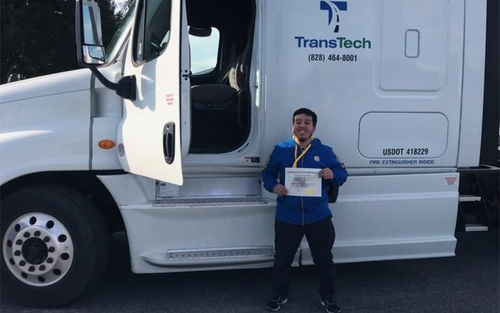
How hard is it to get a CDL?

How to get your CDL – 7 simple steps for new truck drivers


- Register / Login
- Trucker's Forum
- Paid CDL Training
- Truck Driving Jobs
- CDL Practice Tests
- High Road Training
Pre-Trip Inspection Study Guide

Our Pre-Trip Inspection Study Guide has everything you need to prepare for the Class A CDL Pre-Trip Inspection Exam . Our study guide will cover the pre-trip inspection terminology as well as a thorough list of all of the parts you will be inspecting on the vehicle. For each part you will be inspecting there will also be a list of items you will be checking for. Our study guide is broken down into the following sections:
- What You Need to Know About Pre-Trip Inspection
Pre-Trip Inspection Practice Questions
- Pre-Trip Inspection Checklist
Pre-Trip Inspection Videos
Pre-trip inspection printable resources, what you need to know about the pre-trip inspection.
The Pre-Trip Inspection is a thorough inspection of the vehicle and all of its major systems. Inspecting the vehicle before driving each day is a Federal requirement and normally takes about 15 minutes. It must be logged in your logbook as "on duty not driving."
You will have to do thorough safety inspections of the coupling system, the vehicle lights, engine compartment, tires and brakes, the chassis, the fuel tanks, and an in-cab inspection.
The following information is a brief summary of Daniel's Complete Pre-Trip Inspection taken from our oustanding free PDF download:
Engine Compartment
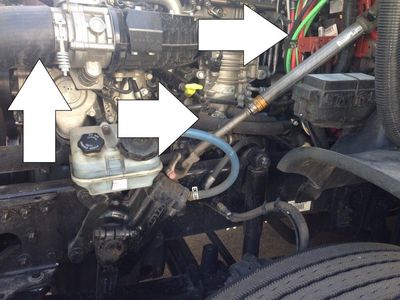
You will be checking the engine compartment for any sort of leaks. You will also be checking to see if all components are properly mounted and secured. None of the mounts must be cracked, bent, or broken.
You will be checking all hoses to make sure they aren't leaking, frayed, or sliced and the fluid levels including the oil level, the coolant, and the power steering fluid.
You must check the components like the water pump, the power steering pump, and the alternator to make sure nothing is leaking, the belts are not frayed, and that everything is properly mounted and secured.
From inside the engine compartment you will also find the steering system, the front suspension system, and the front brake system. All components of these systems must be properly mounted and secured without anything being cracked, bent, or broken. Finally you will be checking the tires, rims, and axle seals to make sure the tires are properly inflated, the rim isn't bent or cracked, and the axle seals are not leaking.
Fuel Tank And Battery Area

You will be standing along the side of the tractor doing a series of checks on the mirrors, fuel tanks, batteries, exhaust system, and more. You will check to make sure nothing is bent, cracked, broken, or leaking.
Check the mirrors, door hinges, door handle to make sure nothing is cracked, bent, or broken. Check to make sure there is no fuel leaking and that the fuel cap is secured and the gasket is not missing.
Check the exhaust system to make sure nothing is cracked, bent, or broken. Check the driveshaft, cat walk, and steps to make sure nothing is cracked, bent, or broken.
Check the frame and crossmembers for structural integrity. Check the air lines going to the trailer to make sure they're properly connected and that there are no abrasions, bulges, or cuts. Make sure the gaskets are present.
Check the suspension system and brakes on the drive axles, making sure nothing is cracked, bent, or broken. Make sure the brake linings are the proper thickness and that the air bags and properly inflated. Inspect the brake chambers, slack adjusters, and pushrods are properly mounted and secure. Not Cracked, Bent, or Broken. With the brakes released and pulled by hand, the Push Rod should not move more than 1 inch.
Check the rims, tires, and axle seals of the drive tires for proper inflation, no leaks around the seal, and the lugs are all present and secured.
Coupling System

You will be standing where the tractor and trailer are connected and you'll start by checking the electrical line and air lines to make sure they're properly mounted and secure at both ends. No abrasions, bulges or cuts. Not leaking air. Make sure the electrical line has no wires exposed. Check the gladhands to make sure the seals are in good condition, no cracks or signs of dry rotting. Not leaking air.
Check the skid plate of the fifth wheel and the apron of the trailer to make sure there is no debris and nothing is cracked, bent, or broken. Make sure the fifth wheel is properly greased. Also make sure there is no gap in between the fifth wheel and the trailer apron once the tractor and trailer are coupled. Make sure the kingpin of the trailer is properly mounted and not cracked, bent, or broken and that the locking jaws of the fifth wheel are properly secured when the tractor and trailer are coupled.
Check the mounting bolts where the fifth wheel attaches to the tractor frame. Make sure there are no missing bolts and that everything is secured properly. Check the locking pin if you having a sliding fifth wheel to make sure it's properly locked into place.
Make sure that there is the proper clearance space between the tractor mudflap and the trailer landing gear so that they don’t hit each other when making a turn.

You will start inspecting the trailer at the head board, which is the front wall of the trailer. Make sure there are no holes or missing rivets. Check the landing gear to make sure it is properly mounted and secure. Not cracked, bent, or broken. Make sure the fully raised and the handle is secure in the cradle when the tractor and trailer are coupled.
Check the frame and crossmembers under the trailer to make sure they're not cracked, bent, or broken. Check the tandem frame and release pins to make sure the frame is in good condition and the release handle and locking pins are in the fully locked position.
You will check the entire suspension and brake system for the trailer tandems the same way you did for the drive axles of the tractor. You will also make sure the mudflaps are properly secured. For dual tires check to see that there is proper space between the tires and there is nothing stuck between the tires.
Check the rear door and hinges to make sure they are properly mounted and nothing is cracked, bent, or broken. Make sure the door seals are not worn, torn, or dry rotted.
Light Check

You will be checking all of the lights and reflectors on both the tractor and the trailer. Check the reflectors and reflective tape to make sure they are properly mounted and secure, not cracked, bent, or broken, and clean and illuminated. Check that you have the proper color of amber to the front and sides, and red to the rear.
Start by turning on your marker lights and headlights. Now walk around the entire truck and trailer and point out the lights. Give the function of the light and the location. You should then ask your examiner to help you check your five functions.
While you're sitting in the drivers seat, the examiner will stand to the front of the truck, then behind the trailer. He will then check your Turn Signals, Four Way Flashers and Brake Lights. You must do each function at every location.
The five locations that you must check your lights:
- Front of the Truck
- Both sides of the Truck
- Rear of the Truck
- Both sides of the Trailer
- Rear of the Trailer
The Five Functions you are checking for:
- Left Turn Signal
- Right Turn Signal
- Four Way Flashers
- High Beams/Low Beams
- Brake Lights

In-Cab Inspection
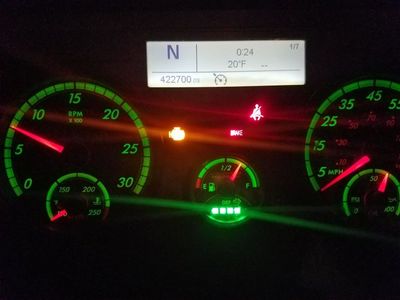
The in-cab inspection and air brake check will cover the various gauges and systems inside the cab along with several tests to make sure you air brake system is working properly.
You will start by checking the following:
- Seat Belt- Properly Mounted and Secure. Not ripped or frayed Adjusts and latches properly.
- Fire Extinguisher- Properly Mounted and Secure. Fully charged
- Three Red Reflective Triangles- My three red reflective triangles are GIVE LOCATION
- Spare Electrical Fuses- My spare electrical fuses are GIVE LOCATION
- Volmeter, Oil Pressure Gauge, Water Temperature Gauge, and Air Pressure Gauge all show proper operation
- City horn and air horn functioning properly
- The windshield and mirrors are clean, no cracks or breaks, no obstructions. The mirrors are in proper adjustment.
- Windshield Wipers and Washers - Demonstrate that the washers work by spraying the windshield. The Wipers are: Properly Mounted and Secure and operate smoothly. The blades aren't cracked or dry rotten.
- Heater and Defroster - Demonstrate that both the Heater and Defroster are working properly.
- Lighting Indicators - Left Turn, Right Turn, Four Way Flashers, and High Beams.
Trailer Parking Brakes - Set the Trailer Brake, release the tractor brake, and then tug lightly on the trailer.
Tractor Parking Brakes- Then set the Tractor Brake, release the trailer brake, and then tug lightly on the tractor.
Service Brake Check - Release both Tractor and Trailer Brakes. Now drive at idle speed. Apply the Service Brake to make sure you come to a complete stop, and that it doesn't pull to the left or right when applying the brakes.
Air Brake Test
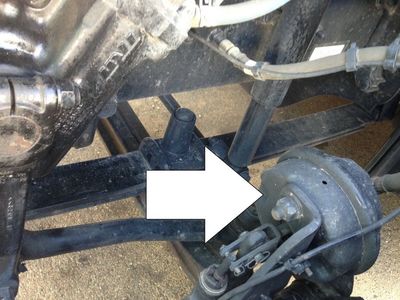
The air brake test will consist of a leakdown test to make sure your air brakes aren't leaking air and losing pressure. It will also test the warning lights and buzzer to make sure the driver gets the proper warning if the air pressure drops too low.
There are three stages to an Air Brake Test
#1: Applied Pressure Test
#2: Warning Light and Buzzer
#3 Tractor/Trailer Protection Valve Pop Out
Applied Pressure Test: Build the air pressure to governor cut out. Put the truck in the lowest gear. Then turn off the engine Immediately turn the engine back on. Push in both the tractor and trailer valves. (This will release the parking brakes.) Push and hold the Brake pedal fully. Allow the gauges to stabilize. Announce the gauges have stabilized and the Primary and Secondary PSI. With the Brakes fully pressed, you should not lose more than 4 PSI in one minute. Announce that you are listening for air leaks during that minute.
Warning Light and Buzzer Test: Pump down on the Brake pedal until the warning light and buzzer comes on, at or before 60 PSI.
Tractor/Trailer Protection Valve Pop Out Test: Pump down on the brake pedal until both the tractor and trailer protection valves pop out. They should both pop out between 40 and 20 PSI.
We have a ton of Pre-Trip Inspection Practice Questions along with the answers and a complete scoring system in our Free Online CDL Practice Tests :
The Engine Compartment Section will include questions about checking the oil level and coolant levels, inspecting belt-driven engine components (like the water pump, alternator, and air compressor), and the safety devices required in the cab. There will also be questions regarding the windshield wipers and free play in the steering wheel.
The Lights And Brakes Section will include questions about dashboard indicator lights, inspecting the parking brakes, and doing a leakdown test on the air brakes. It will also include questions about the low air pressure warning signal and testing your air horn and city horn.
The Suspension And Steering Section will include questions about the tractor protection valve, inspecting the steering box, and inspecting many suspension system parts. It will also include questions about welds being present on tire rims and the minimum tread depth required on steering axle tires.
The Tires And Coupling Devices Section will include questions about shiny trails or rusty threads on lug nuts, inspecting the battery box and cover, and inspecting electrical lines. It will also contain questions about inspecting the coupling devices and the fifth wheel skid plate.
The Emergency Equipment And Fifth Wheel Section will include questions about additional emergeny equipment required by school buses, inspecting the gap between the kingpin apron and the fifth wheel skid plate, and the landing gear securement. It will also contain questions about inspecting driver mirrors and the trailer frame.
Pre-Trip Inspection Checklist - Class A
Our pre-trip inspection checklist covers every part of the truck from front to back, both inside and outside of the truck. It covers the air brakes, suspension parts, steering components, wheels and rims, fuel tanks, batteries, lights, and more. It also covers the air brake tug test and checks for everything under the hood including alternator, water pump, fuel pump, fluids, and more.
This is a super handy checklist to study anytime you have a few minutes to spare:
Pre-Trip Inspection Checklist - Free Word Document Download (Editable Version)
Pre-Trip Inspection Checklist - Free PDF Download (Print Version)
Pre-Trip Inspection Video By Apex CDL Institute
Jeff from Apex Institute does an in-depth explanation of the entire pre-trip inspection process. This video is loaded with tips that go beyond the CDL test to help drivers really understand how to identify problems.
Pretrip Inspection Self-Test By CDL College
The Pretrip Inspection Self-Test By CDL College is really unique. It's a silent video which will show you the part you're inspecting and then gives you a few seconds to figure out what you should be checking for before giving you the answer. Definitely check this one out. Great for practicing before the CDL exam.
Pre-Trip Inspection Video By Averitt Express
This is a complete back to front pre-trip inspection of a truck and trailer by Averitt mainentance associate Kevin Breeding. This thorough pre-trip inspection covers all inportant points of inside the cab, lights, engine, the tractor itself and the trailer.
We have included two print versions of the pre-trip inspection process from Daniel. The first is the entire pre-trip inspection and the second is an abbreviated checklist for the inspection.
- PDF: Daniel's Pre-trip Inspection (Print Version)
- PDF: Daniel's Pre-trip Inspection Checklist (Print Version)

Why Join Trucking Truth?

- The High Road Training Program
- The High Road Article Series
- The Friendliest Trucker's Forum Ever!
- Email Updates When New Articles Are Posted
Apply For Paid CDL Training Through TruckingTruth
Did you know you can fill out one quick form here on TruckingTruth and apply to several companies at once for paid CDL training? Seriously! The application only takes one minute. You will speak with recruiters today. There is no obligation whatsoever. Learn more and apply here:
- Privacy Policy

The Federal Register
The daily journal of the united states government, request access.
Due to aggressive automated scraping of FederalRegister.gov and eCFR.gov, programmatic access to these sites is limited to access to our extensive developer APIs.
If you are human user receiving this message, we can add your IP address to a set of IPs that can access FederalRegister.gov & eCFR.gov; complete the CAPTCHA (bot test) below and click "Request Access". This process will be necessary for each IP address you wish to access the site from, requests are valid for approximately one quarter (three months) after which the process may need to be repeated.
An official website of the United States government.
If you want to request a wider IP range, first request access for your current IP, and then use the "Site Feedback" button found in the lower left-hand side to make the request.
Join 100,000+ Drivers
- Sponsorship
- Thinking of Becoming a Truck Driver?
- Getting a CDL License
- Trucking Driving Jobs Guide
- Trucking Company Guide
- Trucker Life
- Paid CDL Training
- CDL Schools
- Professional Driving Skills + Knowledge
- Owner Operator
- Latest Articles
- Truck Driver Skills
The Pre-Trip Inspection: A Practical Guide For the Truck Driver
Updated February 24th, 2022
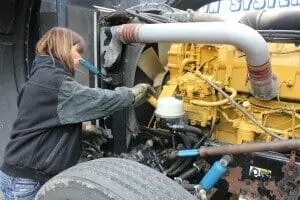
The pre-trip inspection is an integral part of every road trip for a trucker.
It’s probably the most disliked and most often overlooked part of the job of the professional truck driver in the trucking industry.
This inspection is meant to be a thorough check of the truck, trailer and load.
The check is to ensure that everything is in correct working order, prior to the truck and driver, departing on a trip.
Any damage or issues found during the pre-trip inspection which needs attention, must be addressed before departure.
CDL Test Pre-Trip Inspection
If you just came through the process of getting your CDL, you can breathe a sigh of relief.
You don’t have to check all 500 or so items that you had to memorize for the test every single day.
Out on the road, a thorough pre trip shouldn’t take more than 10 to 15 minutes.
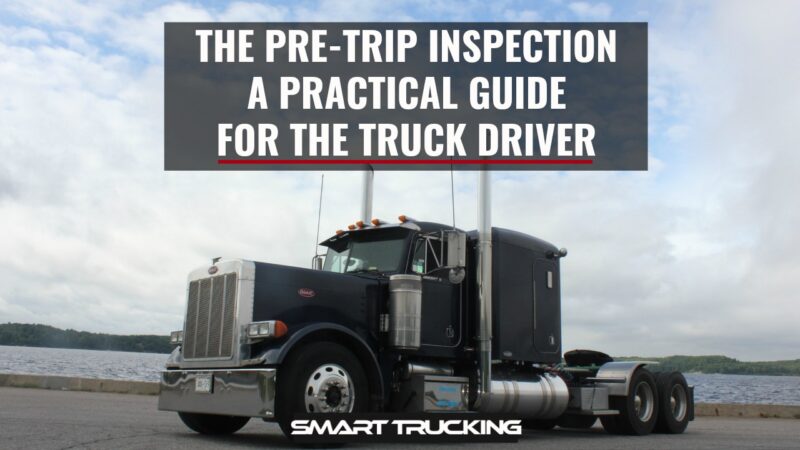
DVIRs – Daily Vehicle Inspection Report
According to federal law ( FMCSR Section 396.11 ), every day, a driver must submit a Daily Vehicle Inspection Report (DVIR) for each power unit he operates. Multiple trailers can go in one report.
DVIRs are either paper or electronic.
Not every trucking company (ahem) enforces this policy, so some truck drivers can go months or years without submitting a DVIR.
Minimum DOT Pre-Trip Inspection Requirements
- Service brakes including trailer brake connections
- Parking brake
- Steering mechanism
- Lighting devices and reflectors
- Windshield wipers
- Rear vision mirrors
- Coupling devices
- Wheels and rims
- Emergency equipment
Your trucking company’s DVIR might be more thorough.
This is a thorough Q&A on DVIRs which you can refer to.
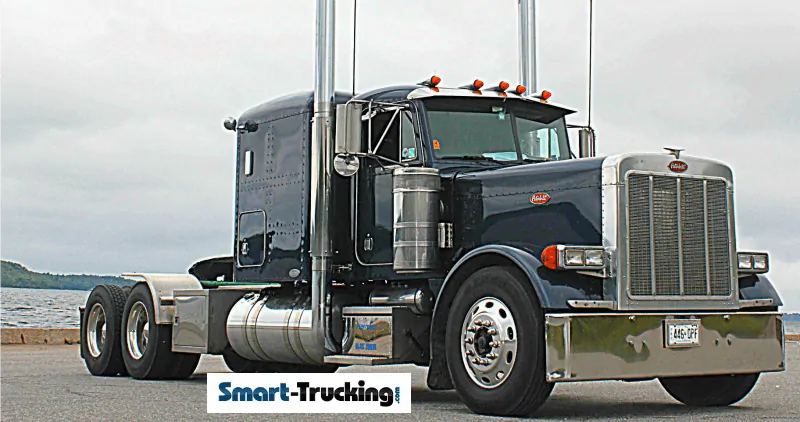
Inspecting a New Truck
When you are assigned a new truck (either daily or just once), there are a few additional things you need to check for on the pre-trip inspection.
Truck Compliance
- Cab card and book – This is a book containing the registration, inspection, permits, cab cards, IFTA paperwork, and any other important papers for the truck. Make sure it is in the truck and all the paperwork is up to date.
- Inspection sticker – This is outside the truck. Find it and make sure the truck is not overdue.
- IFTA stickers – These are the fuel tax compliance stickers. They are on both sides of the truck. Make sure the current year is displayed.
- Elog device – Most trucks are required to have a working elog device.
- Required permits – These are in the cab card book. The most common permits are Heavy Motor Vehicle Trip Permit (Oregon) and the Weight Distance Tax Permit (New Mexico).
- New York HUT sticker – This is usually on the front of your truck. It’s a type of permit.
- License plate – Make sure the license plates on the front and back of the truck match.
- FMCSA Safety Regulations and Hazardous Materials book – These will be given to you by your company. They must stay in your truck within arms reach from the driver’s seat.
- Paper logbook – If your e-log stops working, you must log your hours in a paper logbook, which must be kept in your truck.
- Medical card – You must keep your current medical card in your truck. Always have your CDL on you as well.
- Orange triangles – You must have 3 triangles for when you break down.
- Fire extinguisher – Must be charged and secured to the truck. No rolling around on the floor.
- Extra fuses – If your truck doesn’t use circuit breakers, you must have spare fuses.
- Load bars and/or straps
- Extra oil, coolant, and windshield washer fluid
- Line antifreeze and diesel anti-gel
- Chains and bungees
- Gladhand seals
- Hammer, wrench, wire cutters, cable cutters, knife with glass-breaker
The Class A Pre-Trip Inspection Process
Unless I have to bobtail to pick up my trailer, I inspect my truck and trailer together.
The best way to memorize a thorough pre trip is to do it the same way each time.
Your process will look different from mine, but as long as you are consistent, you will be less likely to miss anything.
I do the inspection first thing each morning as well as every time I swap trailers.
Paperwork and Trailer
- Check the paperwork. It should be the first thing checked when you get to your truck.
- Match the trailer number to your paperwork. If your trailer has a seal, make sure it matches too.
- Unsealed trailer. If your trailer does not have a seal, open it and confirm the product matches the bills. If you are picking up an empty trailer, open it and make sure it’s actually empty.
- Confirm your destination. Ensure the destination is the same as on your trip sheet or load assignment. If there is a discrepancy, call your dispatcher.
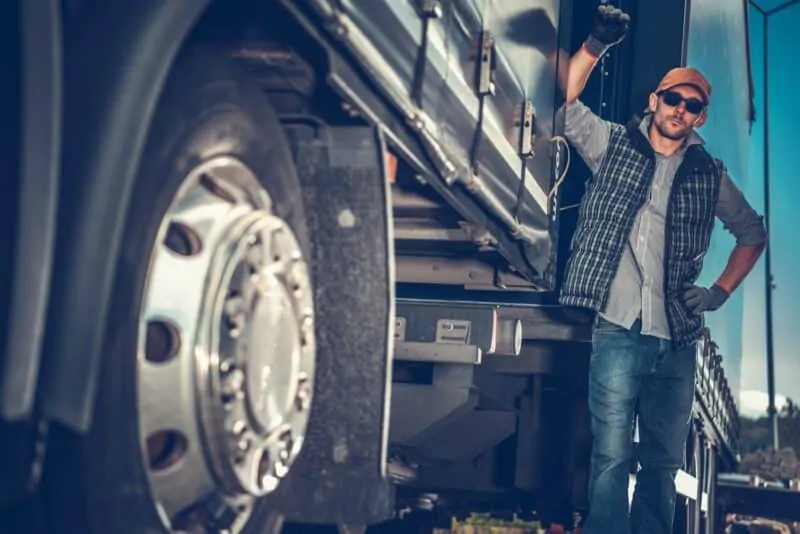
I personally like to start with checking under the hood of the rig. Not everyone does, but I do.
Under the Hood of the Truck
I walk around the front of the truck, making sure all the lights work. Then I open the hood.
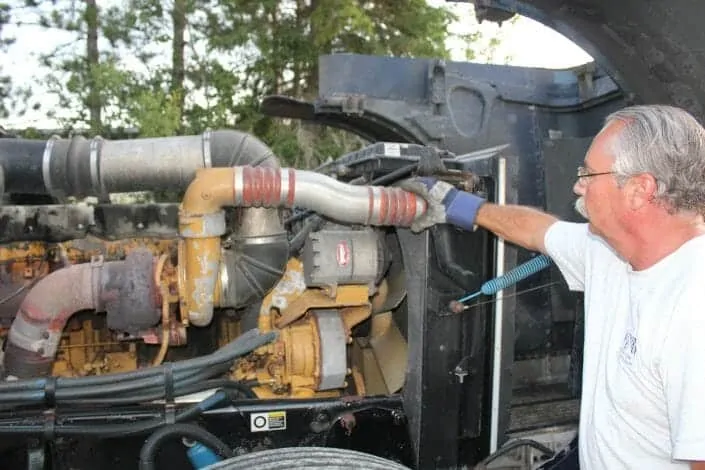
- Fluid levels – Check all fluids: coolant, oil, power steering fluid, and windshield washer fluid. Make sure caps are tight for the rad, oil filler, power steering fluid and the dip-stick is seated properly.
- Alternator, water pump, power steering pump –Make sure these are in good working order, and the belts are not worn or have too much slack.
- Observe at the engine block. Check for leaks, fluid running down the side of the engine. Check for wear, cracking or fraying. Inspect fan belts for proper tension and signs of wear.
- Hoses – Check all hoses for leaks, cracks, and tears.
- Wiring – Check wiring for wear.
- Steering linkage – Check linkage for worn or missing parts.
- Tires – Tires should be properly inflated and have decent tread. If there are flat spots on the tire, it needs to be replaced.
- Hub seal – Make sure it’s not leaking and wiped with oil if transparent.
- Brakes – Brake chambers should not be out of round and should be free of grease. Shoes should not be worn down too much.
- Slack adjusters – Pull slack adjuster. If it travels more than an inch, it needs to be adjusted.
- Suspension – Shocks should be in good condition, and not covered in grease or oil.
Back of the Truck
Next, I check the back of my truck because it’s easier to check this before hooking to a trailer.
- Tires – Tires should be properly inflated and have decent tread. If the tires have flat spots, the tire needs to be replaced.
- Suspension – Shocks and airbags should be in good condition, and not covered in grease or oil.
- Drive shaft – Driveshaft should be undamaged and free of grease. Make sure there is no debris in the u-joints.
- Frame – The frame should not have any welds and not cracked or significantly rusted.
- Fifth wheel – The fifth wheel should be properly greased and not broken.
- Fuel tanks – Fuel tanks should not be leaking.
- Stairs and catwalk – Stairs and catwalk should be free of debris and not broken.
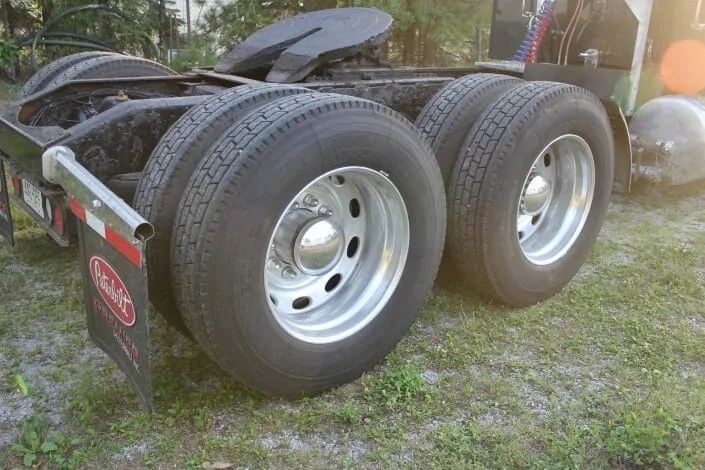
Tires should be checked with a tire gauge.
Tip . This is especially if you are slip seating. Tire thumpers aren’t very accurate. If you use a tire thumper, still check with a tire gauge from time to time.
Drives and tandems should be inflated to 100-110 psi and have a minimum tread or 2/32in. Steer tires should be inflated to 110-120 psi and have a minimum tread of 4/32in.
Tires under 50 psi should be replaced, as they can’t retain enough air pressure.
Flat spots can occur from dragging tandems in the winter or when trying to slide the tandems. Tires with flat spots should be replaced.
Check tires for damage, nails, and punctures.
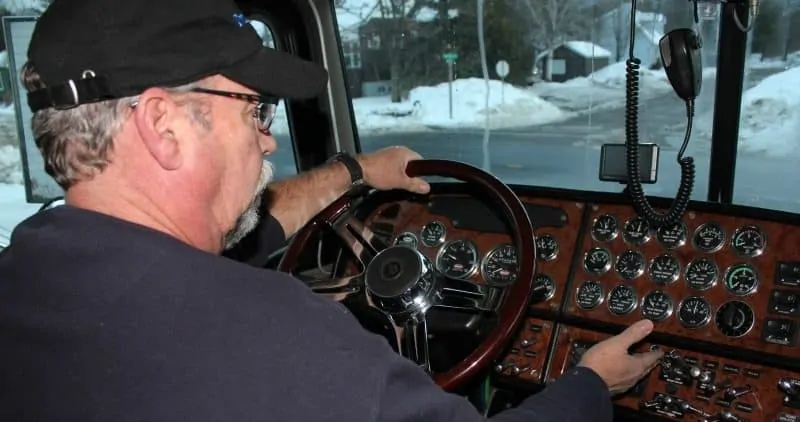
Next, I jump in my cab and start my truck.
- Gauges – Make sure air, oil, and water temperature gauges rise to normal levels.
- Mirrors – Adjust mirrors before moving your truck.
- Windshield wipers – Make sure they work and sit flat against the windshield.
- Horn – Make sure the city and air horns both work.
- Heat and A/C – Check to see if heat and/or air conditioning is working.
- Seat belt – Seat belt should not be frayed and should move freely.
Coupling and Air Lines
This is what could happen if you don’t do the tug test.
The pre-trip inspection is a pretty important thing to do.
Learn your pre-trip procedure and do it when required.

This is why you should always do a tug test when picking up a trailer. The passenger side of the front of the trailer is resting on the frame of the truck and NOT hooked up to the 5th wheel.

The front left corner of the trailer is supported by retracted landing gear only. (Not good!)
The truck driver in this photo (hopefully) learned how critical a pre-trip is. Don’t end up in a pickle like this guy.
Next, I hook up to my trailer.
- Tug test – I back under my trailer until I hear a click, and then immediately do a tug test.
A tug test tests both your coupling and your brakes. If you pull away from your trailer, you aren’t hooked properly.
If you pull your trailer with you, your trailer brakes are out of adjustment. Be absolutely sure to write it up and have it corrected before departure.
- 4 Ways + Headlights. I also turn on my four-way flashers and headlights.
- Airlines and pigtails – Next, hook up airlines and pigtails (electrical connection). Inspect to make sure they aren’t leaking or ripped.
- Visual check of Fifth wheel – Look at the fifth wheel arm under the trailer to make sure it is coupled. The arm should be in.
- Landing gear – Raise the landing gear and check for damage.
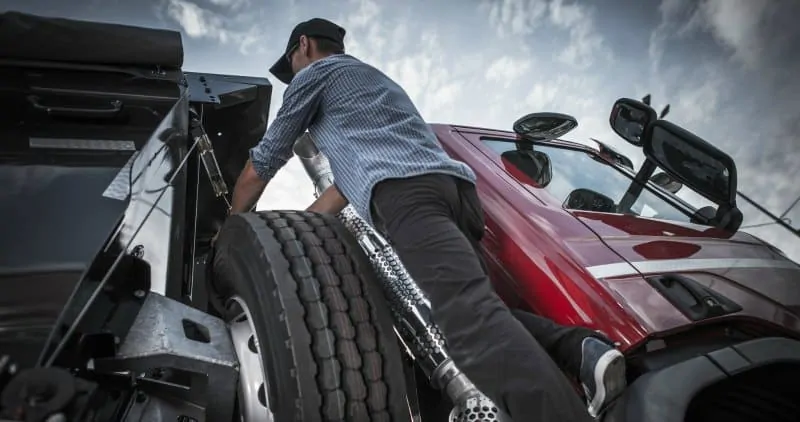
Next, I check the bulkhead (front of the trailer).
- Wall – Make sure the wall is not damaged.
- Inspection sticker – Check the DOT inspection sticker to make sure it’s not out of date.
- Registration paperwork – Check the front trailer box to make sure the registration is good.
- Reefer unit – If you are pulling a reefer, select the pre trip function on the unit and run it. It should be completed by the time you are finished your pre trip inspection.
Next step for the pre-trip inspection is to check the side of the trailer and the tandems.
- Lights – Lights should be on and flashing.
- Suspension – springs or airbags should be in good condition, and not covered in oil or grease.
- Tandem pins – Tandem pins should be locked in position, and slider arm should be in its cradle.
- Cables – Make sure the tandem cables aren’t dragging on the ground.
- Underbelly – Make sure there are no damaged beams under the trailer. Check the entire length.
- Mudflaps – Mud flaps should not be torn and hanging.
Back of Trailer
Next, I check the back of the trailer.
- Doors – Doors and hinges should not be damaged.
- Door latches – Doors should be closed and secured.
- Seal – Seal should be intact and match paperwork.
- DOT bumper – DOT bumper should not be damaged
- License plate – Check for the license plate. They tend to wear out and fall off.
Passenger Side
Next, I check the passenger side.
- Brakes – Brake chambers should not be out of round and should be free of grease.
- Suspension – Springs or airbags should be in good condition, and not covered in grease or oil.
- Mudflaps – Mud flaps should not be torn.
Ready to Roll
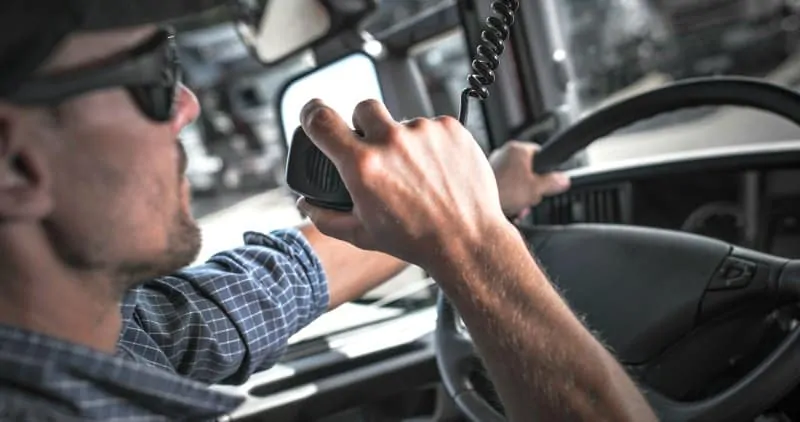
Finally, I jump in my truck and double check my paperwork and destination.
I release my air brakes, roll forward, and push the service brake.
If everything is good, I’m ready to roll.
Post-Trip Inspection
When I’m done for the day, and every time I swap trailers, I do a post-trip inspection. If I am swapping trailers, I do a pre-trip on the new trailer as well.
A post-trip includes:
- lowering the landing gear
- removing the airlines
- uncoupling, and walking around the trailer checking tires, lights, seal, and mudflaps
Then I finish my paperwork and go home.
Slip Seating
If you slip seat (meaning you are in a different truck each shift), your pre- trip check should be more thorough than if you are permanently assigned a truck.
This also applies to the first inspection after being assigned a truck.
Please be courteous and write up any problems or issues found, so the next driver of the vehicle doesn’t have to deal with it.
Side Note: Clean out your truck and throw away any trash. Common courtesy goes a long way in trucking, between drivers.
Pre-Trip Inspection F.A.Q.
Most breakdowns can be avoided with proper preventative measures, such as daily inspections.
Thorough inspections should be done at the start of each shift. Inspections of trailers should be done every time you swap trailers.
Each driver should do a thorough pre-trip every time they swap drivers.
It should take about 10-15 minutes to perform a pre trip inspection.
The DOT. Make sure you stay in compliance so you don’t end up with hefty fines and an out of service.
The best way to memorize your pre trip inspection routine, is to do it the same way every time. That way you’re less likely to miss something. If you have questions, ask your safety team at your company.
Fluids in the engine, engine hoses and wires, brakes and suspension, mudflaps, trailer registration and inspection paperwork, and license plates.
A Few Trip Planning Tips
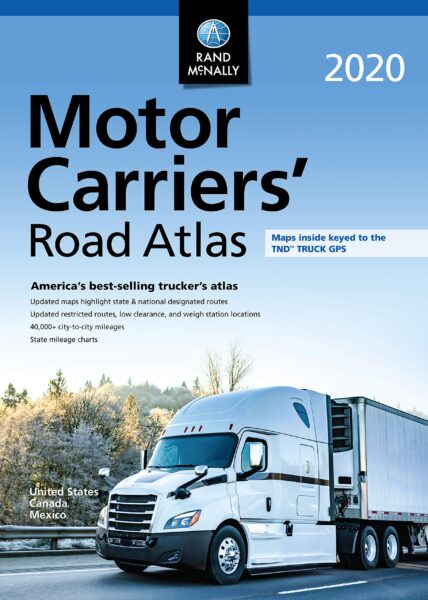
- Buy and learn to read a trucker’s atlas. It’s useful to plan routes and avoid restricted roads. I find this road atlas a necessity as a professional truck driver.
- Buy a decent trucking GPS , but don’t rely on it 100%. Use common sense.
- Don’t use the GPS in your elog device. It will put you in a lake.
Please note that minimum requirements for the inspection are established by the FMCSA.
But these may vary by state, trucking company, truck type, and trailer type.
It is your duty as a professional truck driver to perform a thorough pre-trip inspection before each trip and before you drive.
You’ll save yourself from headaches, fines and unnecessary accidents.
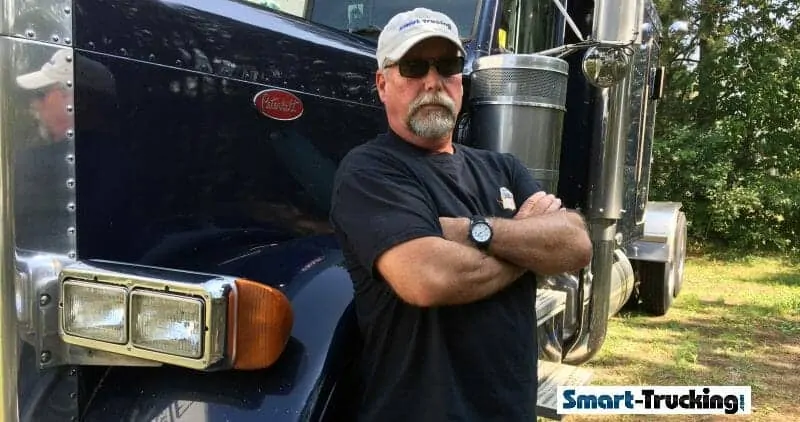
More Articles You May Like
- Trucking Terms – A Guide to Our Industry’s Lingo
- The 18 Wheeler – A Comprehensive Guide to Big Rigs
CDL Truck Driver Skills – Tips, Tricks + Knowledge to Kick Your CDL Skills Up a Notch!
- The D.O.T. Physical- A Guide For the Truck Driver
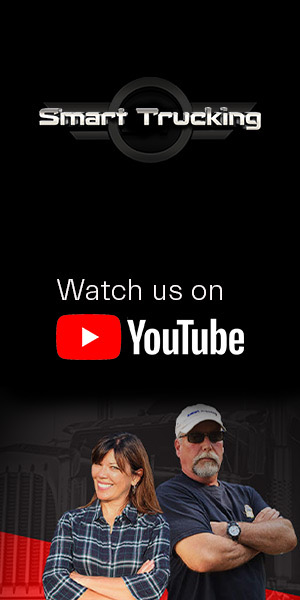
Everything You’ll Want To Know About Paid CDL Training
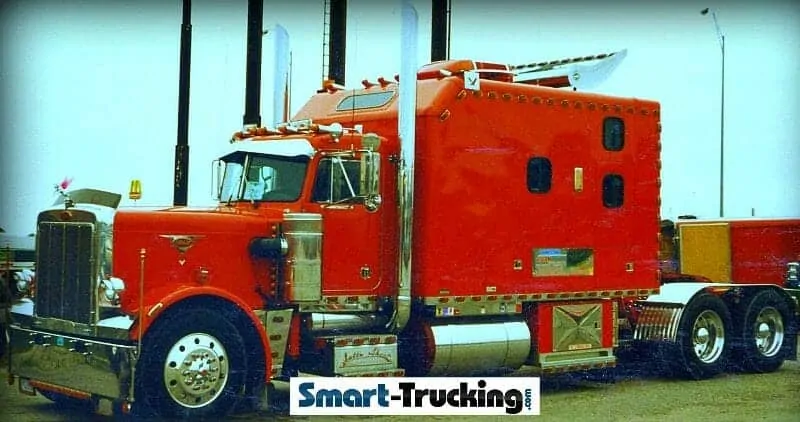
Custom Big Truck Sleepers Photo Gallery Collection
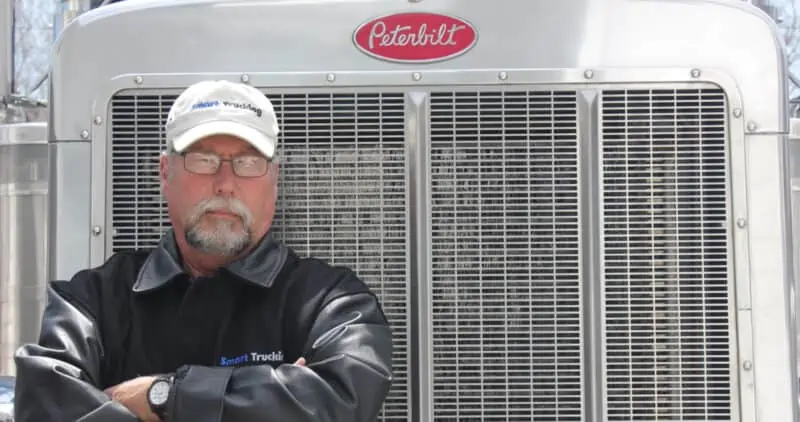
The Best Trucking Companies to Work For 2024 USA
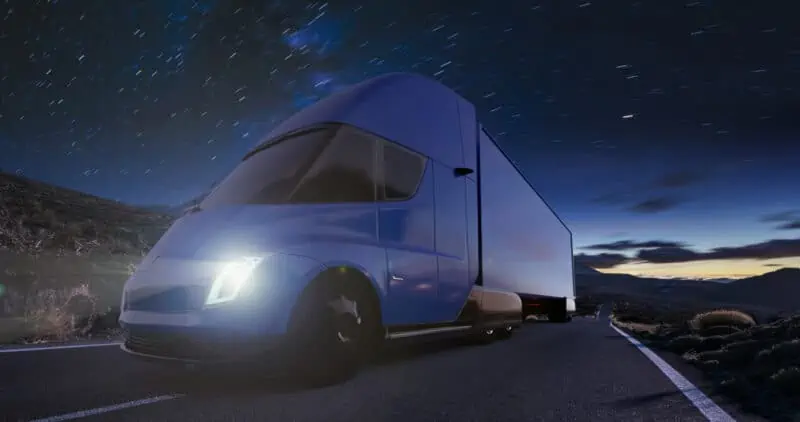
5 Best GPS For Truckers – A Professional Driver’s Guide
Twice a month we email you the best tips and new articles to help you better navigate the trucking industry..
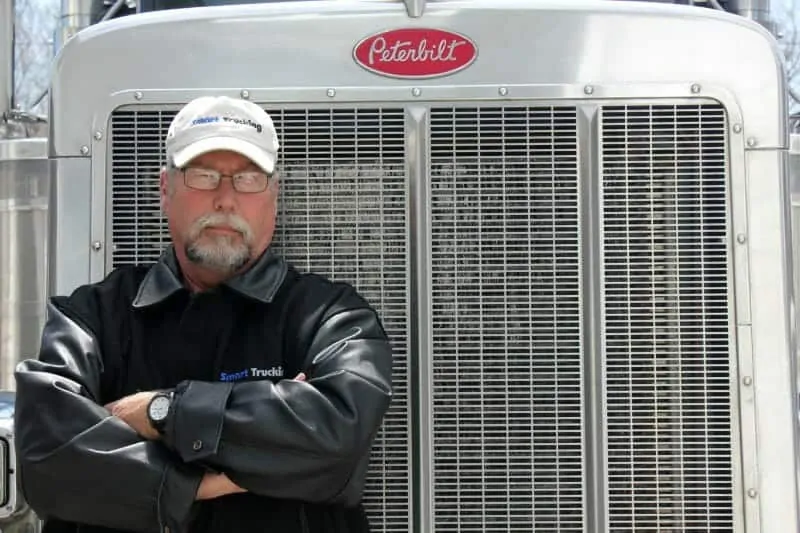
10 Truck Driving Safety Tips Every Professional Driver Should Follow
A veteran 40+ years truck driver shares 10 of the all time, tried and true truck driving safety tips ALL professional truckers should know AND follow! If every driver of EVERY vehicle on the road followed these safety tips, our roads would be SO much safer.
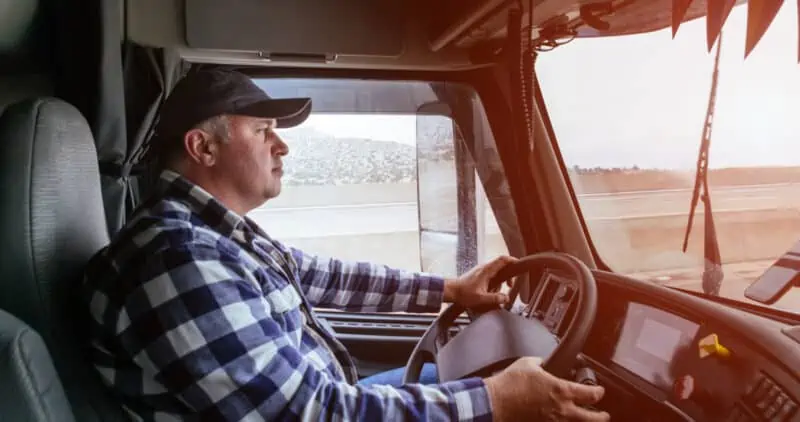
Trucker Tips Master Guide: Expert Advice From Experienced Truck Drivers
A collection of trucker tips from million milers and experienced drivers. These are gold nuggets for the new truck drivers!
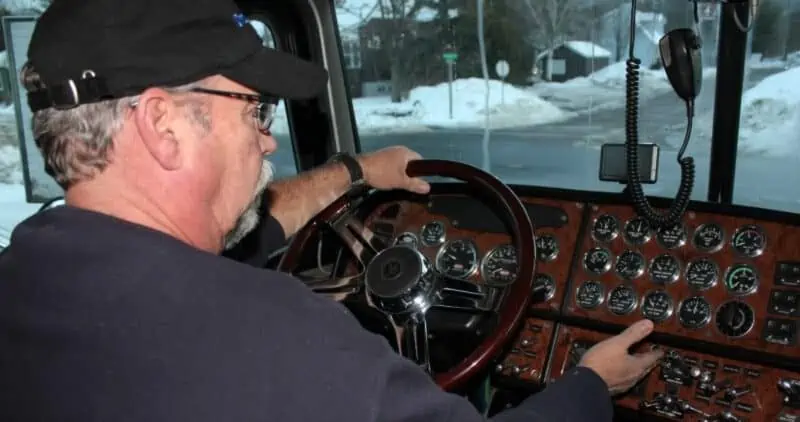
Instruction, clear advice, videos and photos for truck driver skills, maneuvers and information for all professional truck drivers.
A practical guide to paid CDL training programs. Recommended Company Sponsored Schools, Requirements, pros + cons, what to expect from company-sponsored cdl training programs.
Is a Career As a Department of Defense Truck Driver For You?
As a Department of Defense (D.O.D.) truck driver, your role is integral to the logistics and supply chain operations of […]
Navigating Fair Truck Driver Pay: Are You Earning Enough?
Ready to take control of your truck driver pay? Discover key factors impacting your earnings and ensure you’re compensated appropriately […]
The Best Tanker Trucking Companies to Work, U.S., 2024
Top Tanker Trucking Companies in the US To Work For Tanker work typically falls to the ‘better carriers’. Tanker carriers […]
Best Flatbed Trucking Companies, US, 2024: Our Top Picks
There are over 1 million truck drivers working for flatbed trucking companies in the U.S. trucking industry. However, not all […]
Best Trucking Companies For New Drivers in the U.S., 2024
For new drivers entering the trucking industry, diving into the right pool can make all the difference. The foundation of […]
Follow Smart Trucking
- Fleet Training
- CDL Training
- Insurance Discount
- Court Diversion
- Our Courses
- What is the SPIDER Method?
Pre-Trip Inspection: An Essential Guide for Commercial Drivers
Why are pre trip inspections essential, and how can they make a difference in the daily lives of truck drivers? With safety, regulatory compliance, and preventative maintenance on the line, pre trip inspections are a crucial aspect of ensuring smooth and efficient operations on the road. In this blog post, we dive into the critical components of pre trip inspection and provide valuable tips and resources to help drivers stay ahead of potential hazards and costly repairs.
- Pre-trip inspections are essential for promoting safety, compliance, and cost savings while on the road.
- The pre-trip inspection process should take approximately 10–15 minutes and include items such as braking systems, steering & suspension systems, emergency equipment & engine compartment.
- Establishing a routine for pre-trip inspections with sufficient time to check all components is key to ensuring vehicle safety and regulatory compliance. Accurate records must also be kept.
The Importance of Pre-Trip Inspections

- Lessen accident risks
- Comply with regulations
- Maintain the vehicle’s condition
- Avert expensive repairs and downtime
Frequent inspections, such as periodic inspection, are important for maintaining safety and preventing costly issues.
The benefits of conducting pre-trip inspections include:
- Ensuring safety and compliance with regulations like DOT inspections
- Preventing fines, penalties, and potential harm to the driver’s or company’s reputation
- Acting as preventative maintenance, catching minor issues before they escalate
- Saving time, reducing repair costs, and minimizing downtime
Safety Concerns
Ensuring the vehicle’s safety is of paramount importance when conducting pre-trip inspections. A thorough examination of various components is necessary, including:
- Fire extinguishers
- Brake lights
This enables drivers to spot potential hazards and affirm the vehicle’s operational readiness, ultimately reducing the risk of accidents, in line with the goals of the Commercial Vehicle Safety Alliance.
However, the consequences of neglecting a thorough pre-trip inspection can be severe. Overlooking potential hazards may render the vehicle unfit for operation, increasing the risk of collisions. An inspection focused solely on the vehicle can spot these hazards and confirm the vehicle’s safety, underlining the significance of a thorough pre-trip inspection.
Regulatory Compliance
The Federal Motor Carrier Safety Administration mandates pre-trip inspections as part of DOT inspections for commercial motor vehicles, requiring drivers to acknowledge and certify that appropriate repairs have been made before commencing a trip. Non-compliance with pre-trip inspection regulations can result in fines, penalties, and harm to a driver’s or company’s reputation. Conducting periodic inspections can help maintain compliance and ensure the vehicle’s safety.
A Driver Vehicle Inspection Report (DVIR) is an essential tool to guarantee regulatory adherence. Watching a pre-trip inspection video can help drivers understand the process and ensure they follow the correct procedures, further emphasizing the need for thorough pre-trip inspections.
Preventative Maintenance
Preventative maintenance is an essential aspect of vehicle upkeep, aiming to prolong the lifespan of corporate assets, equipment, and infrastructure. By inspecting, cleaning, lubricating, adjusting, and replacing parts as necessary, drivers can detect minor issues before they escalate into major problems, saving time and money on repairs and reducing downtime.
The advantages of preventative maintenance include enhanced safety, increased efficiency, and minimized downtime. By incorporating pre-trip inspections into a regular maintenance routine, drivers can ensure their vehicles remain in optimal condition and avoid unexpected breakdowns or costly repairs.
Pre-Trip Inspection Process
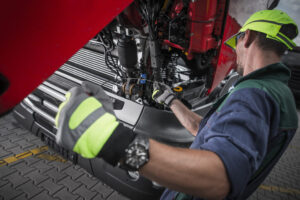
Conducting pre-trip inspections at the start of each shift and each time a trailer swap occurs is integral. Such regularity aids in upholding the vehicle’s safety, roadworthiness, and regulatory compliance while also acting as preventative maintenance. The average inspection should last between 10-15 minutes, allowing enough time for a thorough examination of all components.
Engine Compartment
Inspecting the engine compartment is a critical part of the pre-trip inspection process. Drivers should examine the engine for leaks, fluid levels, belts, hoses, and other critical components to ensure optimal performance and prevent breakdowns. This includes checking the water pump, power steering pump, and alternator for any signs of leakage, fraying of belts, and ensuring that all components are securely mounted.
Additionally, drivers should verify the location of the dipstick and the appropriate oil level, as well as inspect the coolant system for proper levels, hose conditions, and secure mounting at both ends. By carefully examining each part of the engine compartment, drivers can maintain their vehicle’s performance and avoid unexpected issues on the road.
Exterior and Tires
A thorough inspection of the vehicle’s exterior and tires is crucial for ensuring its safety and roadworthiness. This includes checking the lights, reflectors, fuel tank, battery, and tires for any damage or wear that could impact safety or performance. Tires should be inspected for adequate tread, cuts, bubbles, or gouges, and to make sure there are no foreign objects, such as stones or large debris, between the wheels and no space between tires and rims.
Moreover, it is vital to check and maintain the appropriate air pressure in the tires to ensure optimal performance and prevent tire-related accidents. By carefully inspecting the exterior and tires, drivers can guarantee a safer and more efficient driving experience.
cabin and Controls
The cabin and controls of a commercial vehicle play a crucial role in the driver’s safety and comfort on the road. During a pre-trip inspection, drivers should examine the cabin for proper functioning of:
- other essential equipment
They should also ensure the availability of emergency equipment.
In addition to checking seatbelts, mirrors, seat position, steering wheel, pedals, windshield, lights, turn signals, ABS lights, gauges, windshield wipers, and horns, it’s essential to verify that all required emergency equipment, such as fire extinguishers, warning devices, and first aid kits, are present and in good working condition.
By thoroughly inspecting the cabin and controls, drivers can ensure a safe and comfortable driving experience.
Essential Items on a Pre-Trip Inspection Checklist
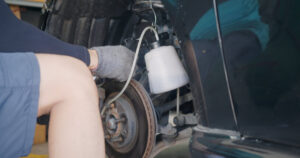
In addition to the aforementioned items, a pre-trip inspection checklist should also include the engine compartment, exterior and tires, and cabin and controls, as previously discussed. Combining all these components in a well-structured checklist ensures a thorough and effective pre-trip inspection that promotes safety and compliance.
Braking System
The braking system is a vital component of any vehicle, and a thorough inspection is necessary to ensure proper functionality and safety. During a pre-trip inspection, drivers should examine all components of the braking system, including air brakes, parking brakes, and hydraulic systems.
Specifically, drivers should inspect the following parts of the service brake system for any signs of wear or damage:
- Brake chamber
- Slack adjuster
By carefully examining each part, drivers can guarantee the vehicle’s safe operation and prevent potential accidents due to brake failure.
Steering and Suspension
A vehicle’s steering and suspension systems play a significant role in ensuring proper handling and a smooth ride. During a pre-trip inspection, drivers should inspect the steering components, suspension system, and wheel alignment to guarantee the vehicle’s optimal performance.
Specifically, drivers should examine the following components of the steering and suspension systems:
- Ball joints
- Tie rod ends
- Strut mounts or shock towers
- Steering effort for both manual and power systems
By thoroughly inspecting these components, drivers can maintain the vehicle’s handling capabilities and provide a comfortable driving experience.
Emergency Equipment
Ensuring the presence and proper functioning of emergency equipment is a crucial part of a pre-trip inspection. Drivers should verify that all required emergency equipment, such as fire extinguishers, warning devices, and first aid kits, are present and in good working condition.
In addition to these items, drivers should also be familiar with the location and operation of any other emergency equipment required by law or their specific company. By confirming the availability and functionality of emergency equipment, drivers can be prepared for unforeseen situations and enhance the overall safety of their vehicle.
Digital Tools and Resources for Pre-Trip Inspections

- Mobile apps that provide checklists and guides for conducting pre-trip inspections
- Online videos and tutorials that demonstrate best practices for inspecting different parts of the truck
- Websites and forums where drivers can stay updated with the latest regulations and requirements for pre-trip inspections
By leveraging these digital tools, truck drivers can enhance their knowledge and efficiency when it comes to pre-trip inspections.
These digital resources not only simplify the pre-trip inspection process but also help drivers maintain compliance with regulations and support preventative maintenance efforts. By leveraging technology, drivers can enhance their pre-trip inspections and promote safety and efficiency on the road.
Mobile Apps
Mobile apps designed for pre-trip inspections can greatly benefit truck drivers by creating checklists, tracking progress, and storing records digitally for easy access and compliance. Some popular mobile apps for pre-trip inspections include iAuditor, Whip Around DVIR software, Teletrac Navman Pre-trip Checklist tool, and Titan GPS Digital Pre-trip Inspection.
By utilizing these apps, drivers can:
- Generate checklists tailored to their specific vehicle and requirements
- Monitor their progress throughout the inspection
- Maintain digital records for future reference and compliance purposes
This not only simplifies the driver only inspection process but also ensures that drivers are following a thorough and effective routine.
Online Videos and Tutorials
Online videos and tutorials serve as valuable resources for truck drivers looking to enhance their pre-trip inspection skills and knowledge. By accessing these resources, drivers can learn best practices for conducting pre-trip inspections and stay updated on regulations and requirements.
Drivers can find online resources on websites, YouTube channels, and other digital platforms that provide informative and instructional content on pre-trip inspections. By staying informed and utilizing these resources, drivers can ensure they are conducting thorough and effective pre-trip inspections that promote safety and compliance.
Tips for a Successful Pre-Trip Inspection
To ensure a thorough and effective pre-trip inspection, truck drivers should establish a routine, take their time, and keep accurate records. Following these tips allows drivers to boost safety, comply with regulations, and bolster preventative maintenance efforts.
Adopting a consistent routine for pre-trip inspections helps ensure that all components are checked and nothing is overlooked. Here are some tips to follow:
- Allow sufficient time for a thorough inspection, typically between 15-30 minutes, to prevent missed issues and potential safety hazards.
- Check all essential components, including tires, brakes, lights, mirrors, and fluid levels.
- Keep detailed records of the inspections, including any issues identified and actions taken.
Regularly review and update your inspection checklist to ensure it covers all necessary items. By following these tips and maintaining a consistent pre-trip inspection routine, you can demonstrate compliance and support preventative maintenance efforts.
Establish a Routine
Developing a consistent routine for conducting pre-trip inspections is crucial for ensuring all components are checked and nothing is overlooked. Adhering to a systematic process lets drivers ensure the vehicle’s safety, roadworthiness, and regulatory compliance.
Some recommended components to include in a pre-trip inspection routine are:
- The engine compartment
- Exterior and tires
- Cabin and controls
- Braking system
- Steering and suspension
- Emergency equipment
By incorporating all of these components into a well-structured routine, drivers can guarantee a thorough and effective pre-trip inspection.
Take Your Time
Allowing sufficient time for a thorough pre-trip inspection is essential to prevent missed issues and potential safety hazards. An average inspection should last between 15-30 minutes, giving drivers enough time to examine all components in detail and ensure the vehicle’s safety and roadworthiness.
Allocating time for pre-trip inspections helps drivers reduce the risk of missing critical issues and affirm the vehicle’s operational readiness. Remember, a thorough vehicle only inspection is not only essential for safety but also for compliance with regulations and preventing costly repairs down the line.
Keep Accurate Records
Maintaining detailed records of pre-trip inspections is essential for demonstrating compliance with regulations and supporting preventative maintenance efforts. Drivers should document any issues identified during the inspection, along with the actions taken to address them.
Maintaining accurate records enables drivers to easily refer back to past inspections and monitor the vehicle’s maintenance history. This not only helps ensure compliance with regulations but also supports proactive maintenance initiatives that can prevent major issues and costly repairs.
In Conclusion
Pre-trip inspections are an essential aspect of ensuring safety, compliance, and preventative maintenance for truck drivers. By following a systematic process, utilizing digital tools and resources, and implementing practical tips, drivers can guarantee thorough and effective inspections that promote safety and efficiency on the road. Remember, a well-executed pre-trip inspection not only minimizes risks but also contributes to a smoother and more enjoyable driving experience.
Frequently Asked Questions
Which of these items should be checked in a pre-trip inspection.
A pre-trip inspection should include thorough safety inspections of the coupling system, vehicle lights, engine compartment, tires and brakes, chassis, fuel tanks, and an in-cab inspection, and must be logged in your logbook as “on duty not driving.” This inspection should be done before every trip to ensure the safety of the driver and other motorists. It is important to check the coupling system for any signs of wear or damage, as well as the vehicle lights, engine compartment, tires and brakes, chassis, and fuel tanks. Additionally, an in-cab inspection should be conducted to ensure that all safety requirements are met.
What is the first step in the pre-trip inspection?
The first step of the pre-trip inspection is to check under the hood, starting at the front of the vehicle and inspecting the various components of the truck’s engine compartment. Begin by checking the oil level, coolant level, and power steering fluid level. Make sure all hoses and belts are in good condition and that all fluid levels are at the proper levels. Check the battery terminals and cables for corrosion and make sure the battery is connected and functioning.
What are the ABSC in a pre-trip inspection?
Pre-trip inspections involve inspecting all parts of a truck and trailer for abrasion, bruises, cuts, bent, broken or cracked parts, and ensuring all air and liquid-holding parts are not leaking. It’s recommended to do the inspection in order, starting with the truck and then the trailer, touching each part and working from the top down and from the center out while wearing gloves.
Which is not checked during an exterior pre-trip inspection?
The reservoir sight glass of the coolant level is not checked during an exterior pre-trip inspection, whereas the oil pressure gauge, wiper arms and blades, horn and heater/defroster should all be checked.
What does DOT mean in inspection?
DOT stands for U.S. Department of Transportation and a DOT inspection is conducted to ensure that commercial motor vehicles are up to standards and safe for public use.

Everything You Need to Know About CDL Medical Requirements

CDL Hours of Service Regulations – Everything You Need to Know
An official website of the United States government Here's how you know
Official websites use .gov A .gov website belongs to an official government organization in the United States.
Secure .gov websites use HTTPS A lock ( Lock A locked padlock ) or https:// means you’ve safely connected to the .gov website. Share sensitive information only on official, secure websites.
FMCSA Frequently Asked Questions Relating to the Waiver of Certain Pre-trip Vehicle Inspection Skills Test Requirements for Certain School Bus Drivers
The Federal Motor Carrier Safety Administration’s (FMCSA) waiver, effective January 3, 2022, permits States to waive the engine compartment component of the pre-trip vehicle inspection skills testing requirement in 49 CFR 383.113(a)(1)(i), known informally as the “under-the-hood” component, for commercial driver’s license (CDL) applicants seeking the school bus (S) and passenger (P) endorsements and the intrastate only (K) restriction. Drivers issued a CDL pursuant to this waiver are restricted to intrastate operation of school buses only.
Additionally, FMCSA waives the requirement in 49 CFR 383.133(c)(1) that States administer this portion of the pre-trip vehicle inspection test in accordance with an FMCSA pre-approved examiner information manual. The FMCSA issued this waiver in response to multiple requests that the Agency provide regulatory relief to address the growing shortage of school bus drivers, which has been exacerbated by the Coronavirus 2019 public health emergency. This waiver is intended for individuals who will operate school buses in intrastate commerce exclusively.
This FAQ document will be updated as additional questions are received.
Question 1: What is the purpose of the waiver?
Answer 1: The purpose of the waiver is to increase the number of school bus drivers by allowing persons to obtain a CDL to operate school buses only in intrastate commerce. An individual licensed under this waiver is not allowed to operate in interstate commerce or operate any commercial motor vehicle other than a school bus.
Question 2: Should drivers who currently hold a CDL be tested in accordance with this waiver?
Answer 2: No. This waiver is intended for individuals who do not currently hold a CDL and are seeking to operate school buses only in intrastate commerce. Individuals who currently hold a CDL and are looking to add a school bus endorsement to an existing CDL are not covered by this waiver and should be tested with the “under the hood” components.
Question 3: Does the waiver require the CDL license to have the K restriction?
Answer 3: Yes. Drivers issued a CDL pursuant to this waiver must be restricted to the intrastate operation of school buses only. The K restriction is the way to identify this limitation on the CDL.
Question 4: If a State decides to adopt the waiver, how does it affect the process for issuing the P endorsement and the S endorsement?
Answer 4: If the individual is seeking to operate a school bus in intrastate commerce only, the State can offer the applicant the skills test without the “under the hood” component, as described in the waiver. In these cases, the issued credential must have a K restriction and a school bus only restriction. If the individual is seeking a CDL with the S and P endorsements with no restrictions, the State is required to test the applicant in accordance with current testing procedures. The State should explain these two options to applicants, so they understand the implication of choosing the restricted license.
Question 5: Is a driver with an existing P endorsement allowed to test for the S endorsement under this waiver?
Answer 5: No. If a driver currently holds a CDL with a P endorsement, a State should not test the individual under the terms of this waiver. The State would test the CDL holder in accordance with current testing procedures for the S endorsement.
Question 6: If a driver already has a Class A or Class B CDL and decides to pursue a school bus and passenger endorsement under this waiver, do the K and school bus-only restrictions only apply to the driver’s school bus operations? Could the driver still operate a Group A property-carrying vehicle in interstate commerce?
Answer 6: No. This waiver is intended for individuals who do not currently hold a CDL and are seeking only to operate school buses in intrastate commerce. Individuals who currently hold a CDL and are looking to operate a school bus or commercial passenger vehicle are not covered by this waiver.
Question 7: How should States score skills tests administered pursuant to this waiver?
Answer 7: If a State issues CDLs under this waiver, the State can decide how to score the items that have been waived to achieve the goals of the waiver, including giving applicants credit for the engine compartment portion of the skills test. The waiver waives 49 CFR 383.133(c), which requires that States administer and score the CDL skills test based solely on the standards contained in the FMCSA pre-approved examiner information manual that conforms to the AAMVA Test Model (49 CFR 383.131(b)). States acting under this waiver may deviate from the skills tests scoring standards set forth in the AAMVA Test Model.
Question 8: Does a State have the option to present only the Form B test for the pre-trip portion of the skills test to school bus applicants subject to the waiver?
Answer 8: No. The State may not present only the Form B test to school bus applicants subject to this waiver. The State may continue to follow its current form selection procedure for the vehicle inspection portion of the CDL skills test.
Question 9: For States that do not have a “school bus only” restriction code, will FMCSA allow flexibility in labeling restricted CDLs issued under this waiver? For example, could a State mark (with a stamp, punch, or label) documents and noted on the license record as “school bus only.”
Answer 9: Yes. A State acting under this waiver is responsible for ensuring that the issued credential clearly states that the driver is restricted to operating a school bus only (in addition to the K restriction) and note that restriction on the CDLIS driver record in accordance with current regulations. If a State does not have a “school bus only” restriction code, the State can physically mark the CDL credential, as long as the mark clearly indicates that the driver is restricted to intrastate operations for school buses only. A punch will not satisfy this requirement unless roadside enforcement officers can easily distinguish that the CDL is valid only for the intrastate operation of school buses.
Question 10: Will FMCSA reimburse States that have incurred additional costs due to making system modifications to their IT system(s) as a result of implementing this waiver?
Answer 10: At this time, FMCSA does not intend to reimburse States for costs incurred as a result of this waiver under the terms of an existing Commercial Driver’s License Program Implementation (CDLPI) grant. If a State needs to modify IT systems as a result of this waiver, the State may submit the project under the Agency’s FY 2022 CDLPI Notice of Funding Opportunity. Applications will be considered under the existing CDLPI grant review process.
Question 11: How will drivers who are issued CDLs under this waiver get the ‘school bus only’ and ‘K’ restrictions removed?
Answer 11: If a State issues CDLs under the waiver, the State can develop its own procedures for removing the school bus only restriction in the future. For example, the SDLA may require the driver to retake the full CDL skills test in the future or simply require that the driver be tested only on the engine compartment Version 1: January 27, 2022 component of the pre-trip vehicle inspection portion of the skills test. States would rely on their current procedures for removing the K restriction.
Question 12: How do States treat reciprocities (license transfers) for individuals obtaining a CDL under this waiver?
Answer 12: A CDL issued under the waiver is valid only within the State that initially issued the CDL. Example: Pursuant to the waiver, State A issues a K-restricted school bus only CDL to an individual who later moves to State B. What happens next depends on whether State B has chosen to issue CDLs pursuant to the waiver. If so, State B would issue the restricted CDL in accordance with the procedures it established to implement the waiver. If State B chose not to issue CDLs pursuant to the waiver, the K-restricted school bus only CDL is not an option for the individual who has moved to State B. In order to obtain a CDL with the S and P endorsements, the individual would be required to follow State B’s regular procedures.
Question 13: How does this waiver impact a driver who would also like to drive charter motorcoaches?
Answer 13: Restricted CDLs issued under this waiver do not permit the holder to operate a charter motorcoach or any commercial motor vehicle other than a school bus in intrastate commerce. Drivers seeking to operate a motorcoach in intrastate or interstate commerce, in addition to a school bus, will be required to obtain a CDL with the S and P endorsements with no restrictions in accordance with current requirements.
Version 1: January 27, 2022

IMAGES
VIDEO
COMMENTS
the inside and the out side inspection for code 10 before starting yard test
I receive comments about pre -trip inspection and I decided to share this information with you guys because I know it will help you to understand some of tho...
After the exterior inspection you will enter the vehicle, check that the handbrake is engaged, the car in neutral and then put on your ignition so you can operate the instruments. The examiner will stand at the front of the vehicle and will instruct you to operate the following: Indicate right. Indicate left. Headlights on.
Getting ready for the test . Outside inspection. That must be dane before the test start.
Printable Pre Trip Inspection Checklist (PDF) CDL Manual. CDL General Knowledge Practice Test. Pre Trip Inspection Practice Test. CDL HAZMAT Endorsement Practice Test. Edited for 2024 on 12/5/23. Complete CDL pre-trip inspection checklist with online reference and study guide plus a free PDF pre trip inspection checklist to print.
A pre-trip inspection checklist is a list of vehicle items that truckers must thoroughly examine before starting a trip. It helps identify and address mechanical and maintenance issues early on and prevent unexpected delays, breakdowns and severe accidents. Performing thorough pre-trip inspections promotes safety, ensures compliance and reduces ...
Practical exams. Skills test. Pre-trip inspection. TSA background check. Retake policy. CDL Maintenance. ELDT Training & Certification. CDL how-to guides. Learn how to conduct thorough pre-trip inspections with our guide, a critical component for commercial vehicle safety.
Code 10 Pre-Trip Inspection. There are no leaks or obstructions under or around the vehicle. The Vehicle's seat belt & the door is working as intended. The vehicle's mirror & windshield is fixed and secure. The vehicle's wiper-blade un-perished. The Vehicle's tyre tread is within spec and the tyre pressure has been checked.
Secondly, brakes should be carefully inspected. This includes checking brake pads, drums or rotors, brake lines, and ensuring proper brake fluid levels. Faulty brakes can lead to accidents or breakdowns, so it is essential to identify any issues before hitting the road. Lights and signals are another critical component of a pre trip inspection.
Push and hold the brake pedal, allowing the gauges to stabilize. When the gauges have stabilized, announce the Primary and Secondary PSI. Listen for air leaks while doing this. Warning Light and Buzzer - Pump down on the brake pedal until the warning light and buzzer comes on. This is typically at or before 60 PSI.
What is a pre-trip inspection? A pre-trip inspection includes checking over the tractor and trailer a truck driver will be operating. A pre-trip should be completed before the operation of a vehicle: At the beginning of a driver's shift. Any time a new trailer is picked up. After a 10-hour break. A thorough inspection usually takes anywhere ...
10-codes . 37 terms. perlabernardino. Preview. Terms in this set (10) In order to put a commercial motor vehicle on the road, you must first: Conduct a thorough pre-trip inspection. Before you inspect the engine compartment and front axle components: verify the parking brakes have been set. What is this minimum tread depth for the steer-tire.
Pre-trip Inspection (396.13) Before operating the vehicle, the driver must inspect the vehicle and be satisfied that it is in safe operating condition. If the last vehicle inspection report notes any deficiencies, the driver must review and sign to acknowledge and certify that the required repairs were made. Periodic Inspection (396.17, 396.21)
S&A Driving School aspects of the K53 driving test, including: *Handling the vehicle *Obedience to traffic rules *Road signs Traffic signals and surface mark...
Our Pre-Trip Inspection Study Guide has everything you need to prepare for the Class A CDL Pre-Trip Inspection Exam. Our study guide will cover the pre-trip inspection terminology as well as a thorough list of all of the parts you will be inspecting on the vehicle. For each part you will be inspecting there will also be a list of items you will ...
A CLD pre-trip inspection checklist helps uncover potentially dangerous conditions, such as unsecured loads or problems with brakes or steering. While it might be tempting for experienced drivers to skip or shortcut a pre-trip vehicle inspection, it's never a good idea. "Better safe than sorry" should be the mantra 100% of the time, and ...
The Code of Federal Regulations ... Pre-trip inspection. Before the beginning of any driveaway-towaway operation of motor vehicles in combination, the motor carrier shall make a careful inspection and test to ascertain that: (1) The tow-bar or saddle-mount connections are properly secured to the towed and towing vehicle;
The pre-trip inspection is an integral part of every road trip for a trucker. It's probably the most disliked and most often overlooked part of the job of the professional truck driver in the trucking industry. This inspection is meant to be a thorough check of the truck, trailer and load. The check is to ensure that everything is in correct ...
The pre-trip inspection process should take approximately 10-15 minutes and include items such as braking systems, steering & suspension systems, emergency equipment & engine compartment. Establishing a routine for pre-trip inspections with sufficient time to check all components is key to ensuring vehicle safety and regulatory compliance.
Section-10M Pre-Trip Vehicle Inspection Test. 10M - 4. 10M.1.2 - Air Brake or Hydraulic Brake Check (based on type of brake system) Air Brake Check (Air Brake Equipped Vehicles Only) Description: Procedures to be followed in inspecting air brake systems. Why Inspect: Air brake safety devices vary. This procedure is designed to make certain ...
Question 1: Must a driver prepare a written report of a pre-trip inspection performed under §392.7? Guidance: No. U.S. DEPARTMENT OF TRANSPORTATION. Federal Motor Carrier Safety Administration. 1200 NEW JERSEY AVENUE, SE. WASHINGTON, DC 20590. 1-800-832-5660. Subscribe to email updates. About. About FMCSA; Regulations; Safety;
On October 27, 2022, FMCSA granted a two year exemption from "Under-the-Hood" CDL skills testing for school bus drivers, which will help those states seeking more time. But, many people remain confused about what existing law requires regarding a driver's inspection of a commercial motor vehicle ("CMV"). Continue reading below for a ...
The Federal Motor Carrier Safety Administration's (FMCSA) waiver, effective January 3, 2022, permits States to waive the engine compartment component of the pre-trip vehicle inspection skills testing requirement in 49 CFR 383.113(a)(1)(i), known informally as the "under-the-hood" component, for commercial driver's license (CDL) applicants seeking the school bus (S) and passenger (P ...